Cultural Influence on PPPs in Australia and China
VerifiedAdded on 2020/04/21
|24
|5963
|309
AI Summary
This assignment delves into the influence of culture on Public–Private Partnerships (PPPs) within both Australia and China. It undertakes a comparative analysis of these two nations, exploring how distinct cultural perspectives shape the implementation and success of PPP projects. The analysis draws upon relevant literature and research to illuminate the key differences in cultural values, communication styles, and decision-making processes that can significantly impact PPP development and execution.
Contribute Materials
Your contribution can guide someone’s learning journey. Share your
documents today.
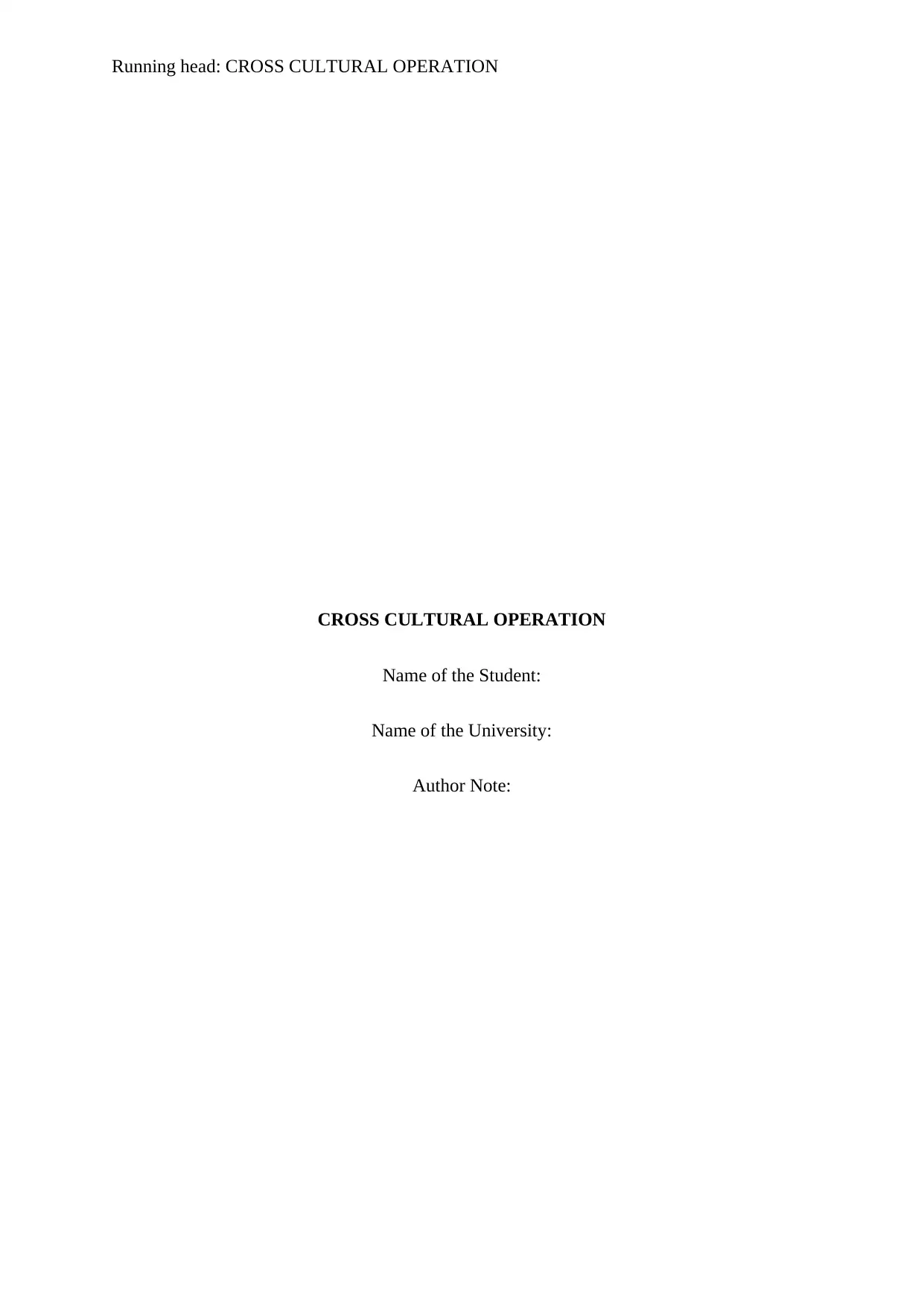
Running head: CROSS CULTURAL OPERATION
CROSS CULTURAL OPERATION
Name of the Student:
Name of the University:
Author Note:
CROSS CULTURAL OPERATION
Name of the Student:
Name of the University:
Author Note:
Secure Best Marks with AI Grader
Need help grading? Try our AI Grader for instant feedback on your assignments.
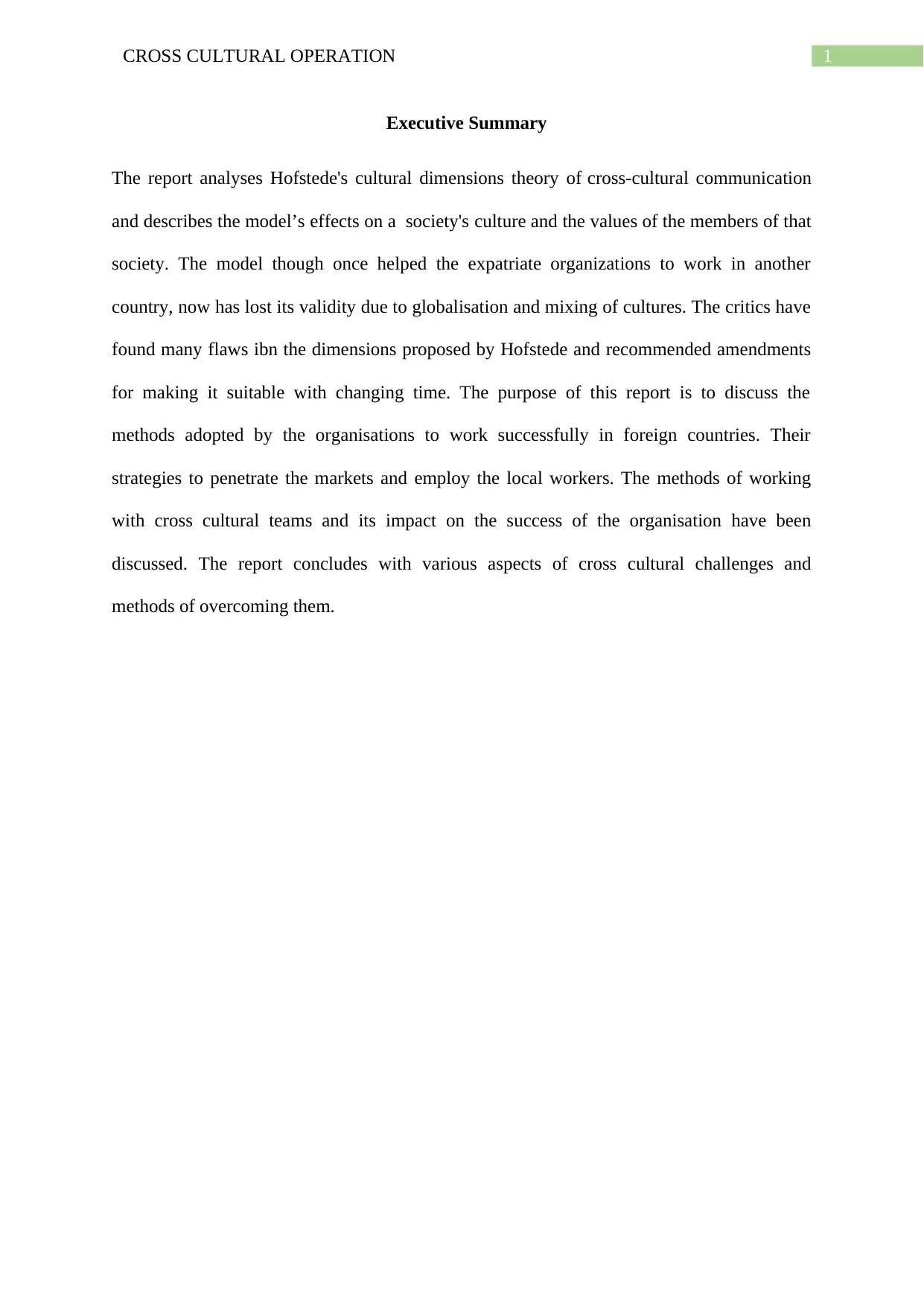
1CROSS CULTURAL OPERATION
Executive Summary
The report analyses Hofstede's cultural dimensions theory of cross-cultural communication
and describes the model’s effects on a society's culture and the values of the members of that
society. The model though once helped the expatriate organizations to work in another
country, now has lost its validity due to globalisation and mixing of cultures. The critics have
found many flaws ibn the dimensions proposed by Hofstede and recommended amendments
for making it suitable with changing time. The purpose of this report is to discuss the
methods adopted by the organisations to work successfully in foreign countries. Their
strategies to penetrate the markets and employ the local workers. The methods of working
with cross cultural teams and its impact on the success of the organisation have been
discussed. The report concludes with various aspects of cross cultural challenges and
methods of overcoming them.
Executive Summary
The report analyses Hofstede's cultural dimensions theory of cross-cultural communication
and describes the model’s effects on a society's culture and the values of the members of that
society. The model though once helped the expatriate organizations to work in another
country, now has lost its validity due to globalisation and mixing of cultures. The critics have
found many flaws ibn the dimensions proposed by Hofstede and recommended amendments
for making it suitable with changing time. The purpose of this report is to discuss the
methods adopted by the organisations to work successfully in foreign countries. Their
strategies to penetrate the markets and employ the local workers. The methods of working
with cross cultural teams and its impact on the success of the organisation have been
discussed. The report concludes with various aspects of cross cultural challenges and
methods of overcoming them.
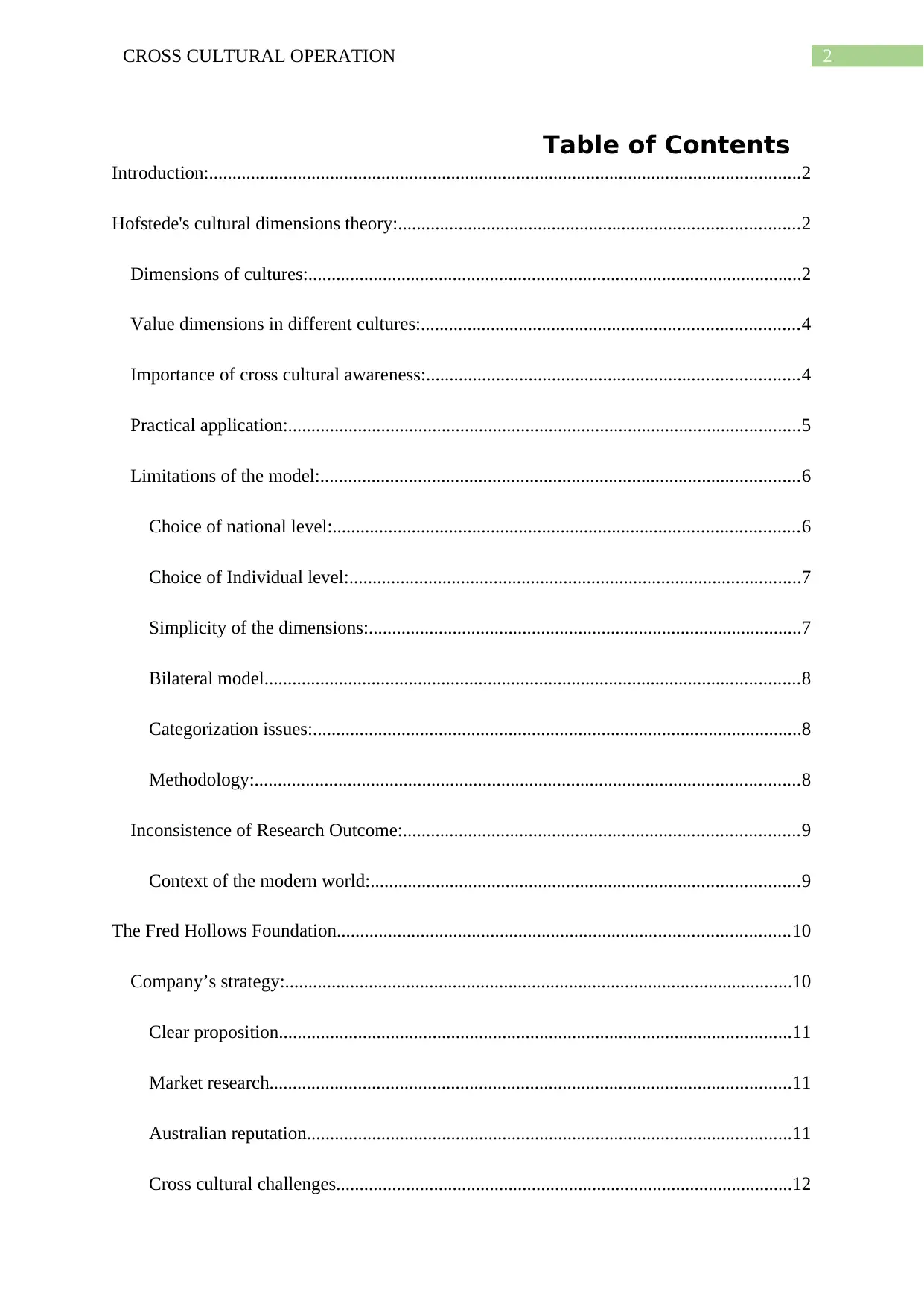
2CROSS CULTURAL OPERATION
Table of Contents
Introduction:...............................................................................................................................2
Hofstede's cultural dimensions theory:......................................................................................2
Dimensions of cultures:..........................................................................................................2
Value dimensions in different cultures:.................................................................................4
Importance of cross cultural awareness:................................................................................4
Practical application:..............................................................................................................5
Limitations of the model:.......................................................................................................6
Choice of national level:....................................................................................................6
Choice of Individual level:.................................................................................................7
Simplicity of the dimensions:.............................................................................................7
Bilateral model...................................................................................................................8
Categorization issues:.........................................................................................................8
Methodology:.....................................................................................................................8
Inconsistence of Research Outcome:.....................................................................................9
Context of the modern world:............................................................................................9
The Fred Hollows Foundation.................................................................................................10
Company’s strategy:.............................................................................................................10
Clear proposition..............................................................................................................11
Market research................................................................................................................11
Australian reputation........................................................................................................11
Cross cultural challenges..................................................................................................12
Table of Contents
Introduction:...............................................................................................................................2
Hofstede's cultural dimensions theory:......................................................................................2
Dimensions of cultures:..........................................................................................................2
Value dimensions in different cultures:.................................................................................4
Importance of cross cultural awareness:................................................................................4
Practical application:..............................................................................................................5
Limitations of the model:.......................................................................................................6
Choice of national level:....................................................................................................6
Choice of Individual level:.................................................................................................7
Simplicity of the dimensions:.............................................................................................7
Bilateral model...................................................................................................................8
Categorization issues:.........................................................................................................8
Methodology:.....................................................................................................................8
Inconsistence of Research Outcome:.....................................................................................9
Context of the modern world:............................................................................................9
The Fred Hollows Foundation.................................................................................................10
Company’s strategy:.............................................................................................................10
Clear proposition..............................................................................................................11
Market research................................................................................................................11
Australian reputation........................................................................................................11
Cross cultural challenges..................................................................................................12
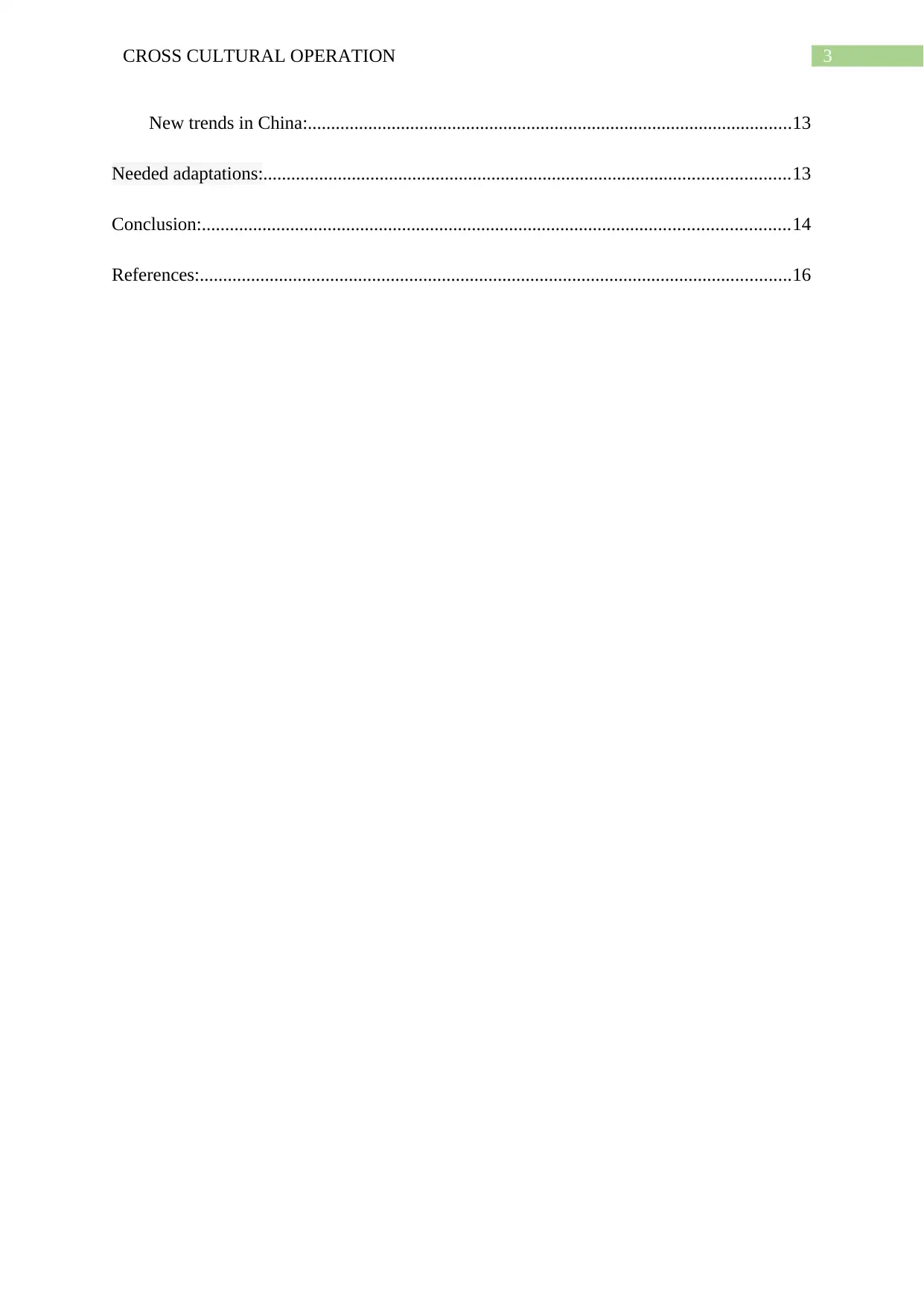
3CROSS CULTURAL OPERATION
New trends in China:........................................................................................................13
Needed adaptations:.................................................................................................................13
Conclusion:..............................................................................................................................14
References:...............................................................................................................................16
New trends in China:........................................................................................................13
Needed adaptations:.................................................................................................................13
Conclusion:..............................................................................................................................14
References:...............................................................................................................................16
Secure Best Marks with AI Grader
Need help grading? Try our AI Grader for instant feedback on your assignments.
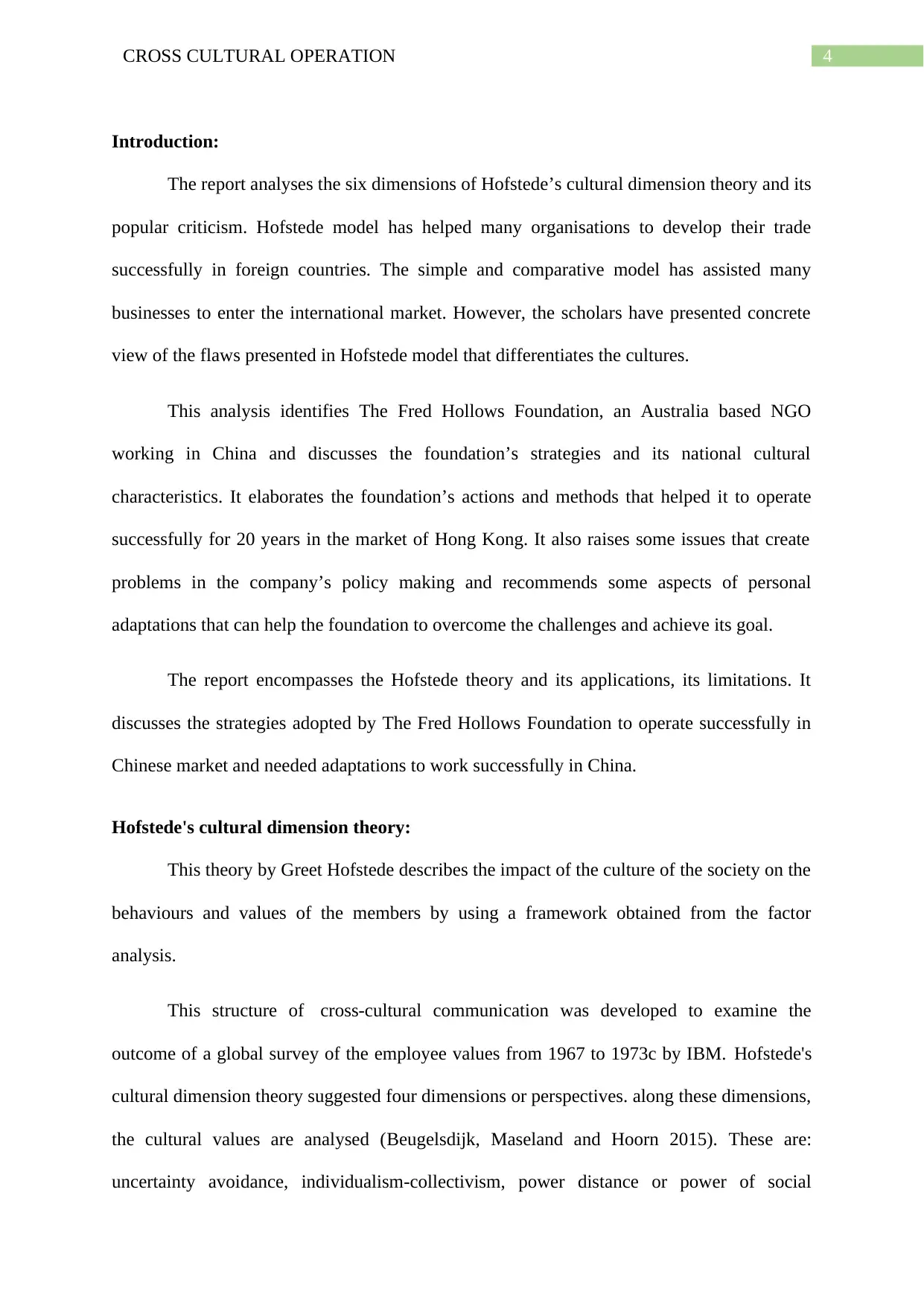
4CROSS CULTURAL OPERATION
Introduction:
The report analyses the six dimensions of Hofstede’s cultural dimension theory and its
popular criticism. Hofstede model has helped many organisations to develop their trade
successfully in foreign countries. The simple and comparative model has assisted many
businesses to enter the international market. However, the scholars have presented concrete
view of the flaws presented in Hofstede model that differentiates the cultures.
This analysis identifies The Fred Hollows Foundation, an Australia based NGO
working in China and discusses the foundation’s strategies and its national cultural
characteristics. It elaborates the foundation’s actions and methods that helped it to operate
successfully for 20 years in the market of Hong Kong. It also raises some issues that create
problems in the company’s policy making and recommends some aspects of personal
adaptations that can help the foundation to overcome the challenges and achieve its goal.
The report encompasses the Hofstede theory and its applications, its limitations. It
discusses the strategies adopted by The Fred Hollows Foundation to operate successfully in
Chinese market and needed adaptations to work successfully in China.
Hofstede's cultural dimension theory:
This theory by Greet Hofstede describes the impact of the culture of the society on the
behaviours and values of the members by using a framework obtained from the factor
analysis.
This structure of cross-cultural communication was developed to examine the
outcome of a global survey of the employee values from 1967 to 1973c by IBM. Hofstede's
cultural dimension theory suggested four dimensions or perspectives. along these dimensions,
the cultural values are analysed (Beugelsdijk, Maseland and Hoorn 2015). These are:
uncertainty avoidance, individualism-collectivism, power distance or power of social
Introduction:
The report analyses the six dimensions of Hofstede’s cultural dimension theory and its
popular criticism. Hofstede model has helped many organisations to develop their trade
successfully in foreign countries. The simple and comparative model has assisted many
businesses to enter the international market. However, the scholars have presented concrete
view of the flaws presented in Hofstede model that differentiates the cultures.
This analysis identifies The Fred Hollows Foundation, an Australia based NGO
working in China and discusses the foundation’s strategies and its national cultural
characteristics. It elaborates the foundation’s actions and methods that helped it to operate
successfully for 20 years in the market of Hong Kong. It also raises some issues that create
problems in the company’s policy making and recommends some aspects of personal
adaptations that can help the foundation to overcome the challenges and achieve its goal.
The report encompasses the Hofstede theory and its applications, its limitations. It
discusses the strategies adopted by The Fred Hollows Foundation to operate successfully in
Chinese market and needed adaptations to work successfully in China.
Hofstede's cultural dimension theory:
This theory by Greet Hofstede describes the impact of the culture of the society on the
behaviours and values of the members by using a framework obtained from the factor
analysis.
This structure of cross-cultural communication was developed to examine the
outcome of a global survey of the employee values from 1967 to 1973c by IBM. Hofstede's
cultural dimension theory suggested four dimensions or perspectives. along these dimensions,
the cultural values are analysed (Beugelsdijk, Maseland and Hoorn 2015). These are:
uncertainty avoidance, individualism-collectivism, power distance or power of social
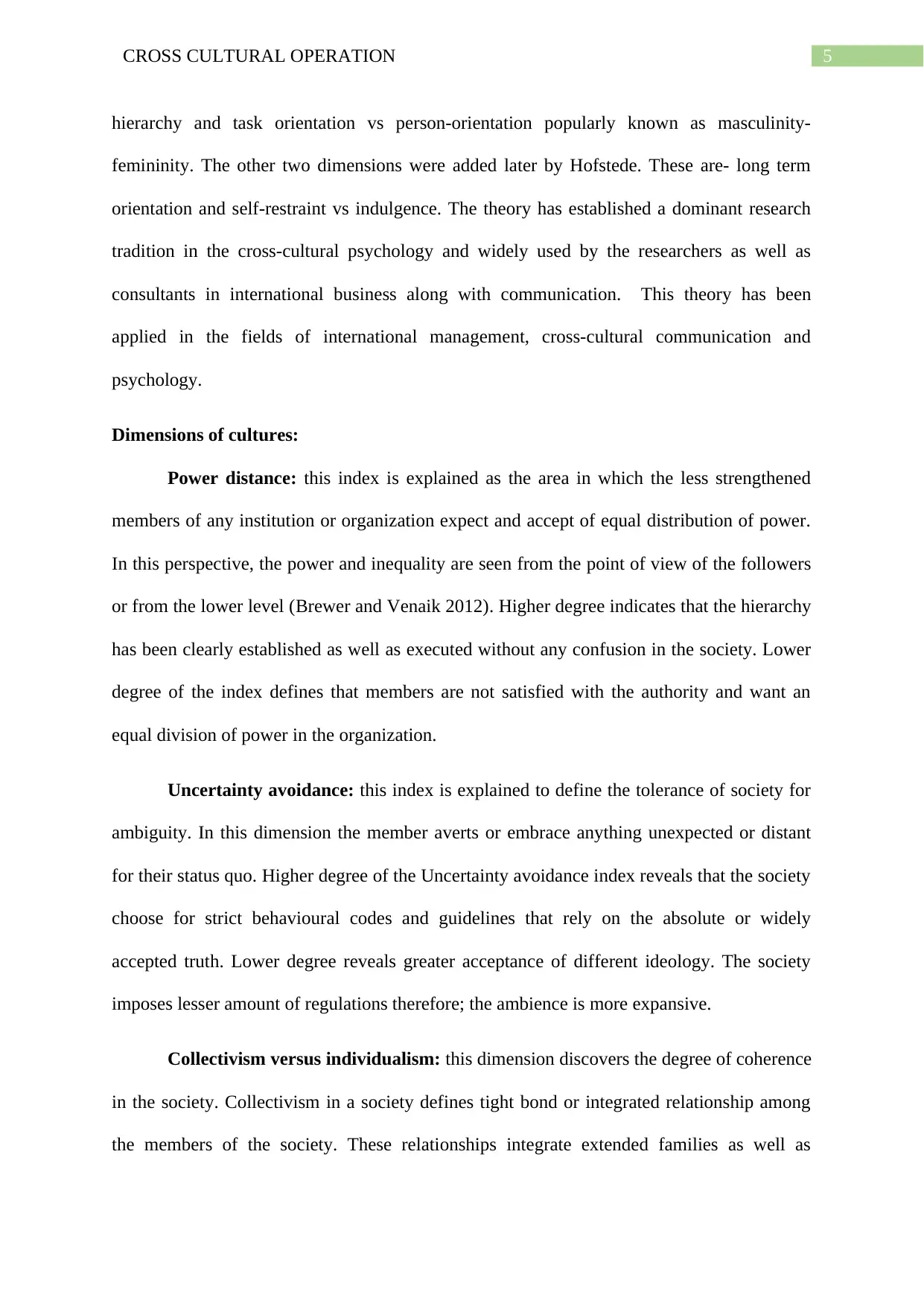
5CROSS CULTURAL OPERATION
hierarchy and task orientation vs person-orientation popularly known as masculinity-
femininity. The other two dimensions were added later by Hofstede. These are- long term
orientation and self-restraint vs indulgence. The theory has established a dominant research
tradition in the cross-cultural psychology and widely used by the researchers as well as
consultants in international business along with communication. This theory has been
applied in the fields of international management, cross-cultural communication and
psychology.
Dimensions of cultures:
Power distance: this index is explained as the area in which the less strengthened
members of any institution or organization expect and accept of equal distribution of power.
In this perspective, the power and inequality are seen from the point of view of the followers
or from the lower level (Brewer and Venaik 2012). Higher degree indicates that the hierarchy
has been clearly established as well as executed without any confusion in the society. Lower
degree of the index defines that members are not satisfied with the authority and want an
equal division of power in the organization.
Uncertainty avoidance: this index is explained to define the tolerance of society for
ambiguity. In this dimension the member averts or embrace anything unexpected or distant
for their status quo. Higher degree of the Uncertainty avoidance index reveals that the society
choose for strict behavioural codes and guidelines that rely on the absolute or widely
accepted truth. Lower degree reveals greater acceptance of different ideology. The society
imposes lesser amount of regulations therefore; the ambience is more expansive.
Collectivism versus individualism: this dimension discovers the degree of coherence
in the society. Collectivism in a society defines tight bond or integrated relationship among
the members of the society. These relationships integrate extended families as well as
hierarchy and task orientation vs person-orientation popularly known as masculinity-
femininity. The other two dimensions were added later by Hofstede. These are- long term
orientation and self-restraint vs indulgence. The theory has established a dominant research
tradition in the cross-cultural psychology and widely used by the researchers as well as
consultants in international business along with communication. This theory has been
applied in the fields of international management, cross-cultural communication and
psychology.
Dimensions of cultures:
Power distance: this index is explained as the area in which the less strengthened
members of any institution or organization expect and accept of equal distribution of power.
In this perspective, the power and inequality are seen from the point of view of the followers
or from the lower level (Brewer and Venaik 2012). Higher degree indicates that the hierarchy
has been clearly established as well as executed without any confusion in the society. Lower
degree of the index defines that members are not satisfied with the authority and want an
equal division of power in the organization.
Uncertainty avoidance: this index is explained to define the tolerance of society for
ambiguity. In this dimension the member averts or embrace anything unexpected or distant
for their status quo. Higher degree of the Uncertainty avoidance index reveals that the society
choose for strict behavioural codes and guidelines that rely on the absolute or widely
accepted truth. Lower degree reveals greater acceptance of different ideology. The society
imposes lesser amount of regulations therefore; the ambience is more expansive.
Collectivism versus individualism: this dimension discovers the degree of coherence
in the society. Collectivism in a society defines tight bond or integrated relationship among
the members of the society. These relationships integrate extended families as well as
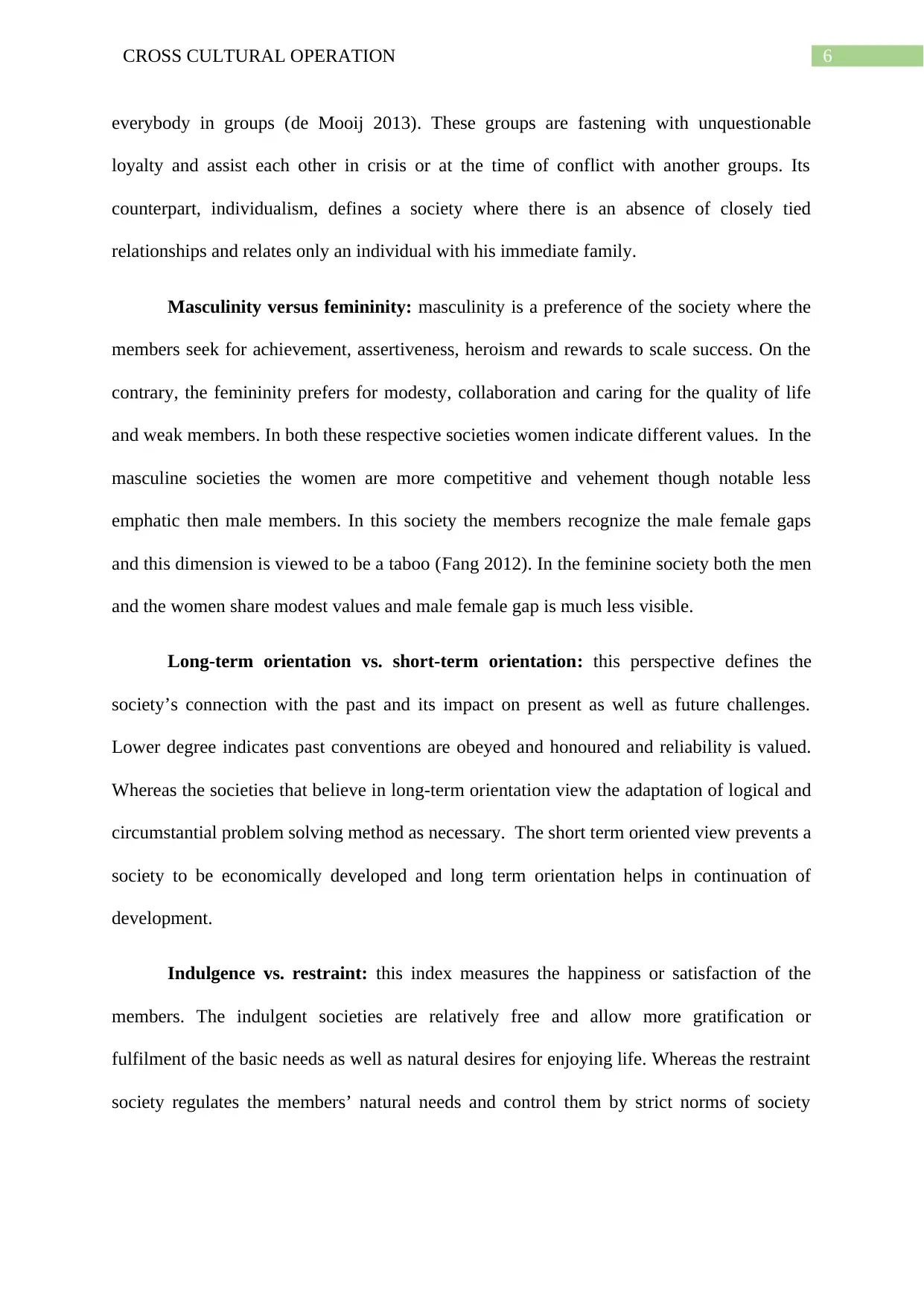
6CROSS CULTURAL OPERATION
everybody in groups (de Mooij 2013). These groups are fastening with unquestionable
loyalty and assist each other in crisis or at the time of conflict with another groups. Its
counterpart, individualism, defines a society where there is an absence of closely tied
relationships and relates only an individual with his immediate family.
Masculinity versus femininity: masculinity is a preference of the society where the
members seek for achievement, assertiveness, heroism and rewards to scale success. On the
contrary, the femininity prefers for modesty, collaboration and caring for the quality of life
and weak members. In both these respective societies women indicate different values. In the
masculine societies the women are more competitive and vehement though notable less
emphatic then male members. In this society the members recognize the male female gaps
and this dimension is viewed to be a taboo (Fang 2012). In the feminine society both the men
and the women share modest values and male female gap is much less visible.
Long-term orientation vs. short-term orientation: this perspective defines the
society’s connection with the past and its impact on present as well as future challenges.
Lower degree indicates past conventions are obeyed and honoured and reliability is valued.
Whereas the societies that believe in long-term orientation view the adaptation of logical and
circumstantial problem solving method as necessary. The short term oriented view prevents a
society to be economically developed and long term orientation helps in continuation of
development.
Indulgence vs. restraint: this index measures the happiness or satisfaction of the
members. The indulgent societies are relatively free and allow more gratification or
fulfilment of the basic needs as well as natural desires for enjoying life. Whereas the restraint
society regulates the members’ natural needs and control them by strict norms of society
everybody in groups (de Mooij 2013). These groups are fastening with unquestionable
loyalty and assist each other in crisis or at the time of conflict with another groups. Its
counterpart, individualism, defines a society where there is an absence of closely tied
relationships and relates only an individual with his immediate family.
Masculinity versus femininity: masculinity is a preference of the society where the
members seek for achievement, assertiveness, heroism and rewards to scale success. On the
contrary, the femininity prefers for modesty, collaboration and caring for the quality of life
and weak members. In both these respective societies women indicate different values. In the
masculine societies the women are more competitive and vehement though notable less
emphatic then male members. In this society the members recognize the male female gaps
and this dimension is viewed to be a taboo (Fang 2012). In the feminine society both the men
and the women share modest values and male female gap is much less visible.
Long-term orientation vs. short-term orientation: this perspective defines the
society’s connection with the past and its impact on present as well as future challenges.
Lower degree indicates past conventions are obeyed and honoured and reliability is valued.
Whereas the societies that believe in long-term orientation view the adaptation of logical and
circumstantial problem solving method as necessary. The short term oriented view prevents a
society to be economically developed and long term orientation helps in continuation of
development.
Indulgence vs. restraint: this index measures the happiness or satisfaction of the
members. The indulgent societies are relatively free and allow more gratification or
fulfilment of the basic needs as well as natural desires for enjoying life. Whereas the restraint
society regulates the members’ natural needs and control them by strict norms of society
Paraphrase This Document
Need a fresh take? Get an instant paraphrase of this document with our AI Paraphraser
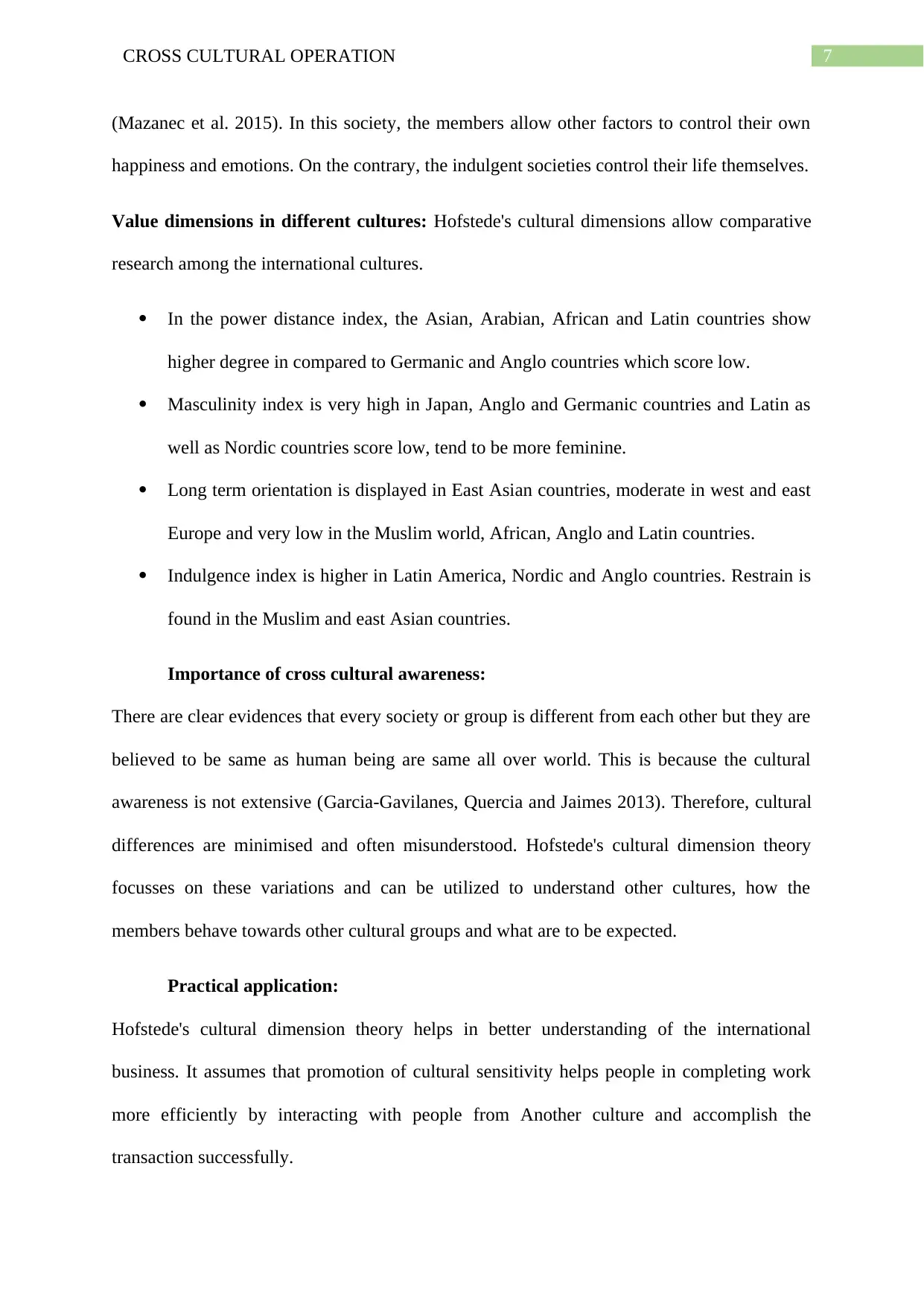
7CROSS CULTURAL OPERATION
(Mazanec et al. 2015). In this society, the members allow other factors to control their own
happiness and emotions. On the contrary, the indulgent societies control their life themselves.
Value dimensions in different cultures: Hofstede's cultural dimensions allow comparative
research among the international cultures.
In the power distance index, the Asian, Arabian, African and Latin countries show
higher degree in compared to Germanic and Anglo countries which score low.
Masculinity index is very high in Japan, Anglo and Germanic countries and Latin as
well as Nordic countries score low, tend to be more feminine.
Long term orientation is displayed in East Asian countries, moderate in west and east
Europe and very low in the Muslim world, African, Anglo and Latin countries.
Indulgence index is higher in Latin America, Nordic and Anglo countries. Restrain is
found in the Muslim and east Asian countries.
Importance of cross cultural awareness:
There are clear evidences that every society or group is different from each other but they are
believed to be same as human being are same all over world. This is because the cultural
awareness is not extensive (Garcia-Gavilanes, Quercia and Jaimes 2013). Therefore, cultural
differences are minimised and often misunderstood. Hofstede's cultural dimension theory
focusses on these variations and can be utilized to understand other cultures, how the
members behave towards other cultural groups and what are to be expected.
Practical application:
Hofstede's cultural dimension theory helps in better understanding of the international
business. It assumes that promotion of cultural sensitivity helps people in completing work
more efficiently by interacting with people from Another culture and accomplish the
transaction successfully.
(Mazanec et al. 2015). In this society, the members allow other factors to control their own
happiness and emotions. On the contrary, the indulgent societies control their life themselves.
Value dimensions in different cultures: Hofstede's cultural dimensions allow comparative
research among the international cultures.
In the power distance index, the Asian, Arabian, African and Latin countries show
higher degree in compared to Germanic and Anglo countries which score low.
Masculinity index is very high in Japan, Anglo and Germanic countries and Latin as
well as Nordic countries score low, tend to be more feminine.
Long term orientation is displayed in East Asian countries, moderate in west and east
Europe and very low in the Muslim world, African, Anglo and Latin countries.
Indulgence index is higher in Latin America, Nordic and Anglo countries. Restrain is
found in the Muslim and east Asian countries.
Importance of cross cultural awareness:
There are clear evidences that every society or group is different from each other but they are
believed to be same as human being are same all over world. This is because the cultural
awareness is not extensive (Garcia-Gavilanes, Quercia and Jaimes 2013). Therefore, cultural
differences are minimised and often misunderstood. Hofstede's cultural dimension theory
focusses on these variations and can be utilized to understand other cultures, how the
members behave towards other cultural groups and what are to be expected.
Practical application:
Hofstede's cultural dimension theory helps in better understanding of the international
business. It assumes that promotion of cultural sensitivity helps people in completing work
more efficiently by interacting with people from Another culture and accomplish the
transaction successfully.
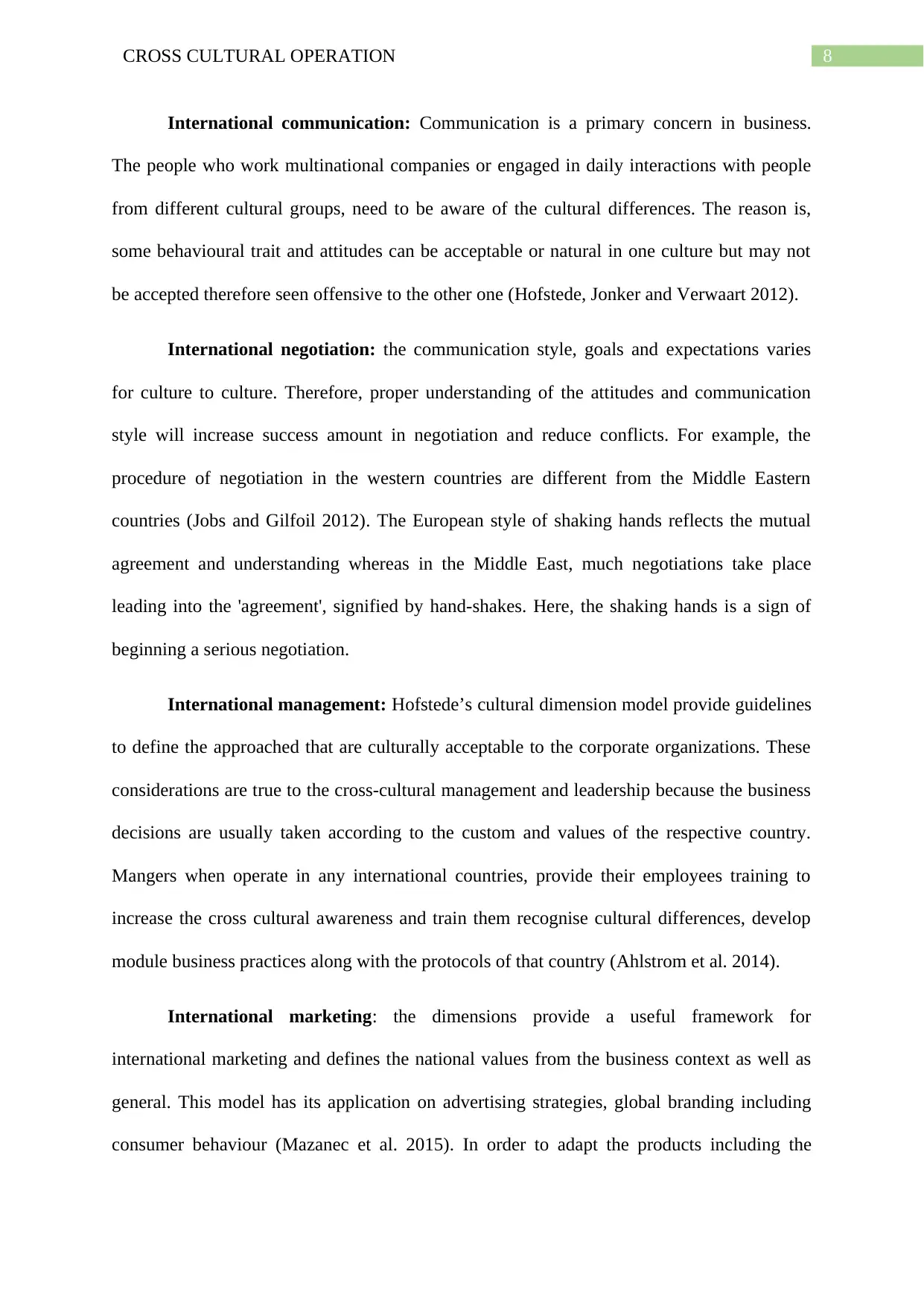
8CROSS CULTURAL OPERATION
International communication: Communication is a primary concern in business.
The people who work multinational companies or engaged in daily interactions with people
from different cultural groups, need to be aware of the cultural differences. The reason is,
some behavioural trait and attitudes can be acceptable or natural in one culture but may not
be accepted therefore seen offensive to the other one (Hofstede, Jonker and Verwaart 2012).
International negotiation: the communication style, goals and expectations varies
for culture to culture. Therefore, proper understanding of the attitudes and communication
style will increase success amount in negotiation and reduce conflicts. For example, the
procedure of negotiation in the western countries are different from the Middle Eastern
countries (Jobs and Gilfoil 2012). The European style of shaking hands reflects the mutual
agreement and understanding whereas in the Middle East, much negotiations take place
leading into the 'agreement', signified by hand-shakes. Here, the shaking hands is a sign of
beginning a serious negotiation.
International management: Hofstede’s cultural dimension model provide guidelines
to define the approached that are culturally acceptable to the corporate organizations. These
considerations are true to the cross-cultural management and leadership because the business
decisions are usually taken according to the custom and values of the respective country.
Mangers when operate in any international countries, provide their employees training to
increase the cross cultural awareness and train them recognise cultural differences, develop
module business practices along with the protocols of that country (Ahlstrom et al. 2014).
International marketing: the dimensions provide a useful framework for
international marketing and defines the national values from the business context as well as
general. This model has its application on advertising strategies, global branding including
consumer behaviour (Mazanec et al. 2015). In order to adapt the products including the
International communication: Communication is a primary concern in business.
The people who work multinational companies or engaged in daily interactions with people
from different cultural groups, need to be aware of the cultural differences. The reason is,
some behavioural trait and attitudes can be acceptable or natural in one culture but may not
be accepted therefore seen offensive to the other one (Hofstede, Jonker and Verwaart 2012).
International negotiation: the communication style, goals and expectations varies
for culture to culture. Therefore, proper understanding of the attitudes and communication
style will increase success amount in negotiation and reduce conflicts. For example, the
procedure of negotiation in the western countries are different from the Middle Eastern
countries (Jobs and Gilfoil 2012). The European style of shaking hands reflects the mutual
agreement and understanding whereas in the Middle East, much negotiations take place
leading into the 'agreement', signified by hand-shakes. Here, the shaking hands is a sign of
beginning a serious negotiation.
International management: Hofstede’s cultural dimension model provide guidelines
to define the approached that are culturally acceptable to the corporate organizations. These
considerations are true to the cross-cultural management and leadership because the business
decisions are usually taken according to the custom and values of the respective country.
Mangers when operate in any international countries, provide their employees training to
increase the cross cultural awareness and train them recognise cultural differences, develop
module business practices along with the protocols of that country (Ahlstrom et al. 2014).
International marketing: the dimensions provide a useful framework for
international marketing and defines the national values from the business context as well as
general. This model has its application on advertising strategies, global branding including
consumer behaviour (Mazanec et al. 2015). In order to adapt the products including the
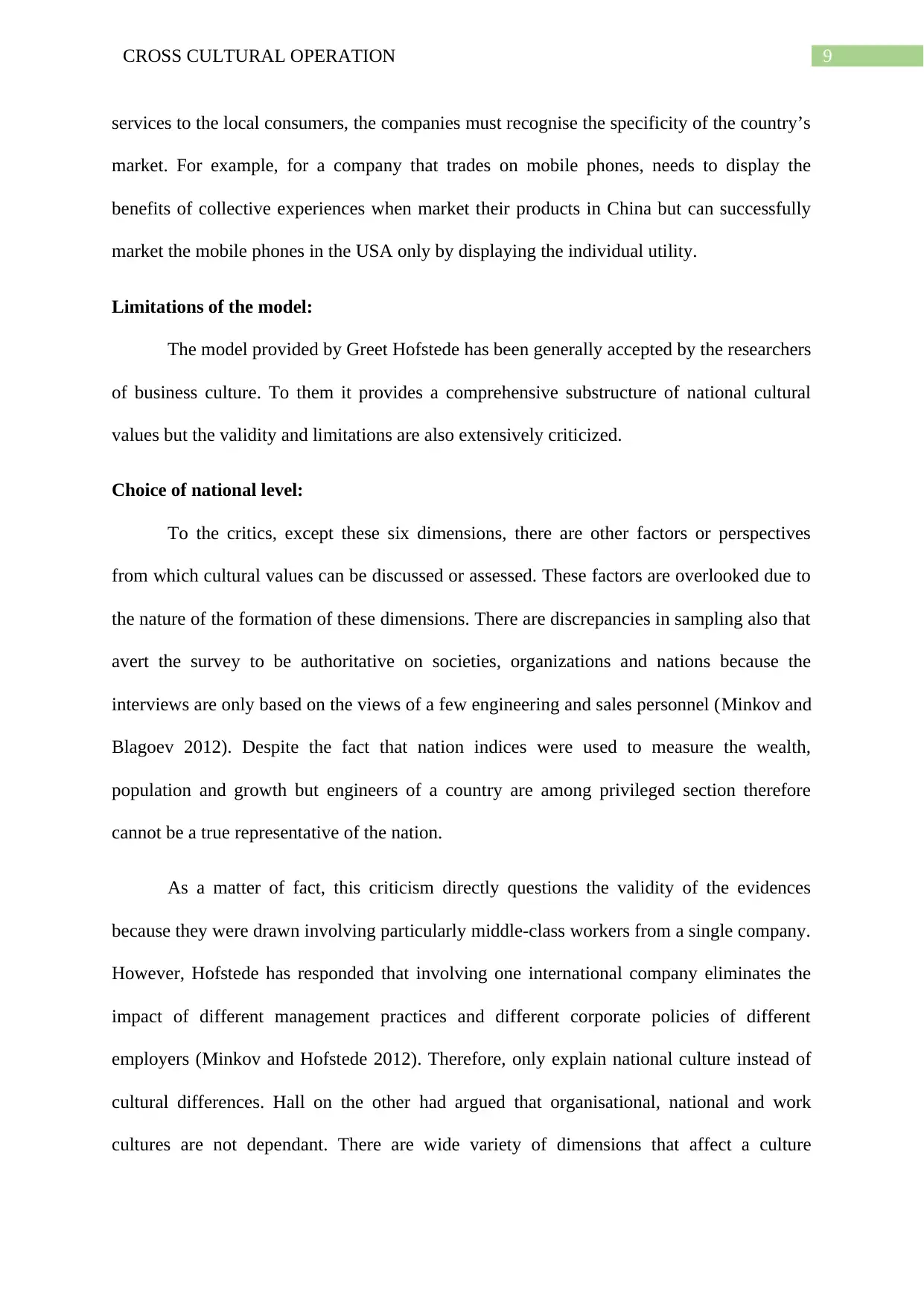
9CROSS CULTURAL OPERATION
services to the local consumers, the companies must recognise the specificity of the country’s
market. For example, for a company that trades on mobile phones, needs to display the
benefits of collective experiences when market their products in China but can successfully
market the mobile phones in the USA only by displaying the individual utility.
Limitations of the model:
The model provided by Greet Hofstede has been generally accepted by the researchers
of business culture. To them it provides a comprehensive substructure of national cultural
values but the validity and limitations are also extensively criticized.
Choice of national level:
To the critics, except these six dimensions, there are other factors or perspectives
from which cultural values can be discussed or assessed. These factors are overlooked due to
the nature of the formation of these dimensions. There are discrepancies in sampling also that
avert the survey to be authoritative on societies, organizations and nations because the
interviews are only based on the views of a few engineering and sales personnel (Minkov and
Blagoev 2012). Despite the fact that nation indices were used to measure the wealth,
population and growth but engineers of a country are among privileged section therefore
cannot be a true representative of the nation.
As a matter of fact, this criticism directly questions the validity of the evidences
because they were drawn involving particularly middle-class workers from a single company.
However, Hofstede has responded that involving one international company eliminates the
impact of different management practices and different corporate policies of different
employers (Minkov and Hofstede 2012). Therefore, only explain national culture instead of
cultural differences. Hall on the other had argued that organisational, national and work
cultures are not dependant. There are wide variety of dimensions that affect a culture
services to the local consumers, the companies must recognise the specificity of the country’s
market. For example, for a company that trades on mobile phones, needs to display the
benefits of collective experiences when market their products in China but can successfully
market the mobile phones in the USA only by displaying the individual utility.
Limitations of the model:
The model provided by Greet Hofstede has been generally accepted by the researchers
of business culture. To them it provides a comprehensive substructure of national cultural
values but the validity and limitations are also extensively criticized.
Choice of national level:
To the critics, except these six dimensions, there are other factors or perspectives
from which cultural values can be discussed or assessed. These factors are overlooked due to
the nature of the formation of these dimensions. There are discrepancies in sampling also that
avert the survey to be authoritative on societies, organizations and nations because the
interviews are only based on the views of a few engineering and sales personnel (Minkov and
Blagoev 2012). Despite the fact that nation indices were used to measure the wealth,
population and growth but engineers of a country are among privileged section therefore
cannot be a true representative of the nation.
As a matter of fact, this criticism directly questions the validity of the evidences
because they were drawn involving particularly middle-class workers from a single company.
However, Hofstede has responded that involving one international company eliminates the
impact of different management practices and different corporate policies of different
employers (Minkov and Hofstede 2012). Therefore, only explain national culture instead of
cultural differences. Hall on the other had argued that organisational, national and work
cultures are not dependant. There are wide variety of dimensions that affect a culture
Secure Best Marks with AI Grader
Need help grading? Try our AI Grader for instant feedback on your assignments.
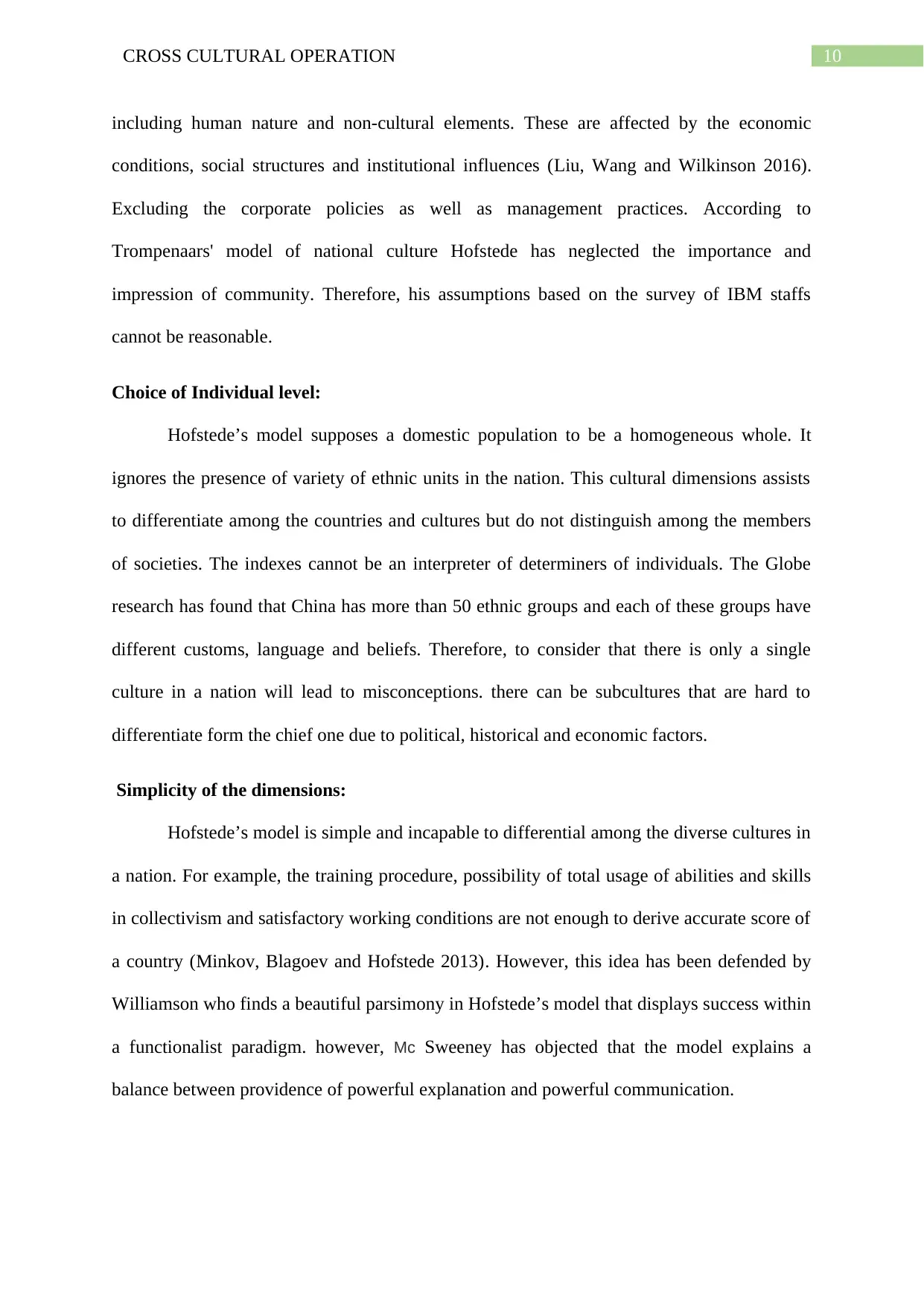
10CROSS CULTURAL OPERATION
including human nature and non-cultural elements. These are affected by the economic
conditions, social structures and institutional influences (Liu, Wang and Wilkinson 2016).
Excluding the corporate policies as well as management practices. According to
Trompenaars' model of national culture Hofstede has neglected the importance and
impression of community. Therefore, his assumptions based on the survey of IBM staffs
cannot be reasonable.
Choice of Individual level:
Hofstede’s model supposes a domestic population to be a homogeneous whole. It
ignores the presence of variety of ethnic units in the nation. This cultural dimensions assists
to differentiate among the countries and cultures but do not distinguish among the members
of societies. The indexes cannot be an interpreter of determiners of individuals. The Globe
research has found that China has more than 50 ethnic groups and each of these groups have
different customs, language and beliefs. Therefore, to consider that there is only a single
culture in a nation will lead to misconceptions. there can be subcultures that are hard to
differentiate form the chief one due to political, historical and economic factors.
Simplicity of the dimensions:
Hofstede’s model is simple and incapable to differential among the diverse cultures in
a nation. For example, the training procedure, possibility of total usage of abilities and skills
in collectivism and satisfactory working conditions are not enough to derive accurate score of
a country (Minkov, Blagoev and Hofstede 2013). However, this idea has been defended by
Williamson who finds a beautiful parsimony in Hofstede’s model that displays success within
a functionalist paradigm. however, Mc Sweeney has objected that the model explains a
balance between providence of powerful explanation and powerful communication.
including human nature and non-cultural elements. These are affected by the economic
conditions, social structures and institutional influences (Liu, Wang and Wilkinson 2016).
Excluding the corporate policies as well as management practices. According to
Trompenaars' model of national culture Hofstede has neglected the importance and
impression of community. Therefore, his assumptions based on the survey of IBM staffs
cannot be reasonable.
Choice of Individual level:
Hofstede’s model supposes a domestic population to be a homogeneous whole. It
ignores the presence of variety of ethnic units in the nation. This cultural dimensions assists
to differentiate among the countries and cultures but do not distinguish among the members
of societies. The indexes cannot be an interpreter of determiners of individuals. The Globe
research has found that China has more than 50 ethnic groups and each of these groups have
different customs, language and beliefs. Therefore, to consider that there is only a single
culture in a nation will lead to misconceptions. there can be subcultures that are hard to
differentiate form the chief one due to political, historical and economic factors.
Simplicity of the dimensions:
Hofstede’s model is simple and incapable to differential among the diverse cultures in
a nation. For example, the training procedure, possibility of total usage of abilities and skills
in collectivism and satisfactory working conditions are not enough to derive accurate score of
a country (Minkov, Blagoev and Hofstede 2013). However, this idea has been defended by
Williamson who finds a beautiful parsimony in Hofstede’s model that displays success within
a functionalist paradigm. however, Mc Sweeney has objected that the model explains a
balance between providence of powerful explanation and powerful communication.
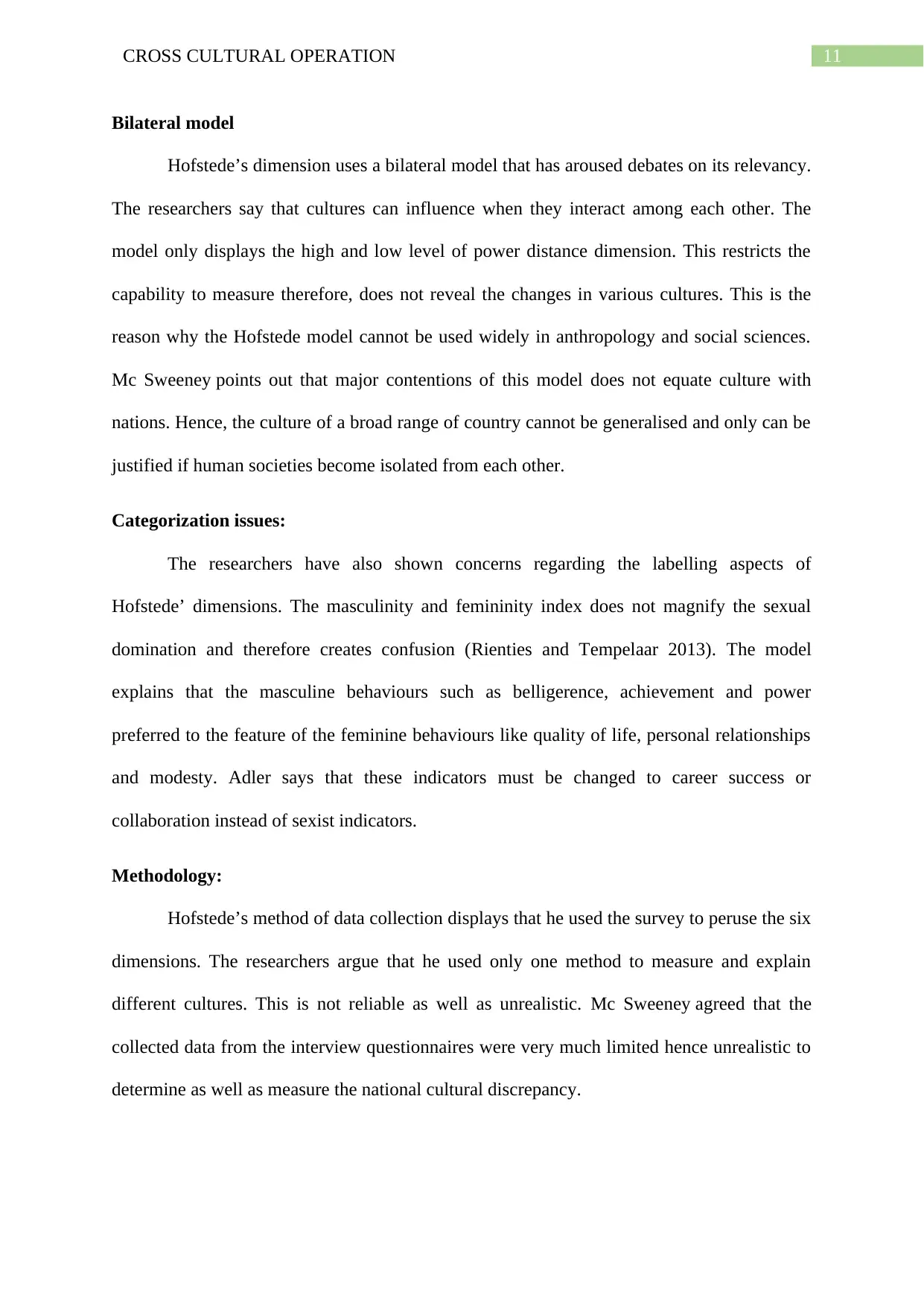
11CROSS CULTURAL OPERATION
Bilateral model
Hofstede’s dimension uses a bilateral model that has aroused debates on its relevancy.
The researchers say that cultures can influence when they interact among each other. The
model only displays the high and low level of power distance dimension. This restricts the
capability to measure therefore, does not reveal the changes in various cultures. This is the
reason why the Hofstede model cannot be used widely in anthropology and social sciences.
Mc Sweeney points out that major contentions of this model does not equate culture with
nations. Hence, the culture of a broad range of country cannot be generalised and only can be
justified if human societies become isolated from each other.
Categorization issues:
The researchers have also shown concerns regarding the labelling aspects of
Hofstede’ dimensions. The masculinity and femininity index does not magnify the sexual
domination and therefore creates confusion (Rienties and Tempelaar 2013). The model
explains that the masculine behaviours such as belligerence, achievement and power
preferred to the feature of the feminine behaviours like quality of life, personal relationships
and modesty. Adler says that these indicators must be changed to career success or
collaboration instead of sexist indicators.
Methodology:
Hofstede’s method of data collection displays that he used the survey to peruse the six
dimensions. The researchers argue that he used only one method to measure and explain
different cultures. This is not reliable as well as unrealistic. Mc Sweeney agreed that the
collected data from the interview questionnaires were very much limited hence unrealistic to
determine as well as measure the national cultural discrepancy.
Bilateral model
Hofstede’s dimension uses a bilateral model that has aroused debates on its relevancy.
The researchers say that cultures can influence when they interact among each other. The
model only displays the high and low level of power distance dimension. This restricts the
capability to measure therefore, does not reveal the changes in various cultures. This is the
reason why the Hofstede model cannot be used widely in anthropology and social sciences.
Mc Sweeney points out that major contentions of this model does not equate culture with
nations. Hence, the culture of a broad range of country cannot be generalised and only can be
justified if human societies become isolated from each other.
Categorization issues:
The researchers have also shown concerns regarding the labelling aspects of
Hofstede’ dimensions. The masculinity and femininity index does not magnify the sexual
domination and therefore creates confusion (Rienties and Tempelaar 2013). The model
explains that the masculine behaviours such as belligerence, achievement and power
preferred to the feature of the feminine behaviours like quality of life, personal relationships
and modesty. Adler says that these indicators must be changed to career success or
collaboration instead of sexist indicators.
Methodology:
Hofstede’s method of data collection displays that he used the survey to peruse the six
dimensions. The researchers argue that he used only one method to measure and explain
different cultures. This is not reliable as well as unrealistic. Mc Sweeney agreed that the
collected data from the interview questionnaires were very much limited hence unrealistic to
determine as well as measure the national cultural discrepancy.
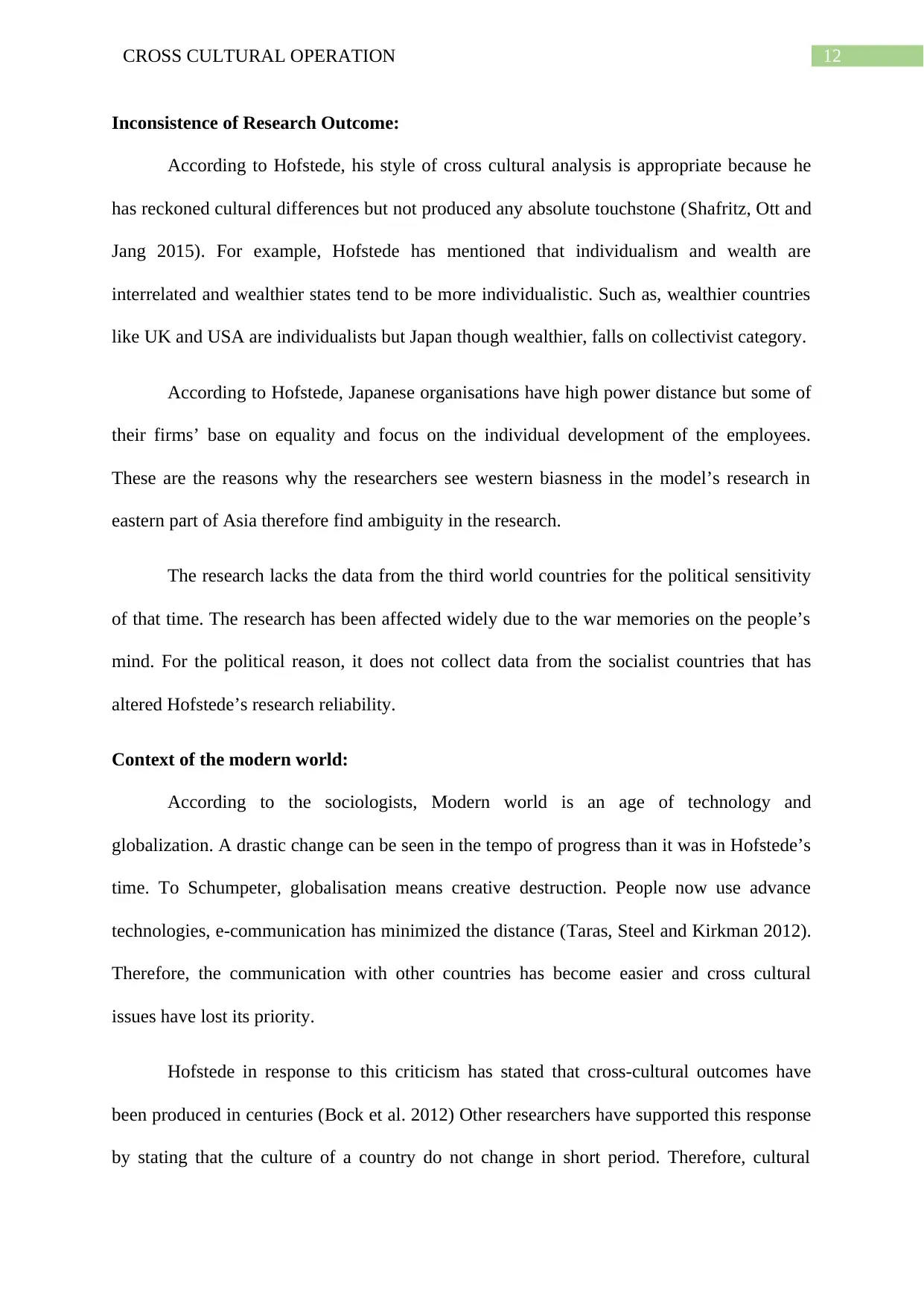
12CROSS CULTURAL OPERATION
Inconsistence of Research Outcome:
According to Hofstede, his style of cross cultural analysis is appropriate because he
has reckoned cultural differences but not produced any absolute touchstone (Shafritz, Ott and
Jang 2015). For example, Hofstede has mentioned that individualism and wealth are
interrelated and wealthier states tend to be more individualistic. Such as, wealthier countries
like UK and USA are individualists but Japan though wealthier, falls on collectivist category.
According to Hofstede, Japanese organisations have high power distance but some of
their firms’ base on equality and focus on the individual development of the employees.
These are the reasons why the researchers see western biasness in the model’s research in
eastern part of Asia therefore find ambiguity in the research.
The research lacks the data from the third world countries for the political sensitivity
of that time. The research has been affected widely due to the war memories on the people’s
mind. For the political reason, it does not collect data from the socialist countries that has
altered Hofstede’s research reliability.
Context of the modern world:
According to the sociologists, Modern world is an age of technology and
globalization. A drastic change can be seen in the tempo of progress than it was in Hofstede’s
time. To Schumpeter, globalisation means creative destruction. People now use advance
technologies, e-communication has minimized the distance (Taras, Steel and Kirkman 2012).
Therefore, the communication with other countries has become easier and cross cultural
issues have lost its priority.
Hofstede in response to this criticism has stated that cross-cultural outcomes have
been produced in centuries (Bock et al. 2012) Other researchers have supported this response
by stating that the culture of a country do not change in short period. Therefore, cultural
Inconsistence of Research Outcome:
According to Hofstede, his style of cross cultural analysis is appropriate because he
has reckoned cultural differences but not produced any absolute touchstone (Shafritz, Ott and
Jang 2015). For example, Hofstede has mentioned that individualism and wealth are
interrelated and wealthier states tend to be more individualistic. Such as, wealthier countries
like UK and USA are individualists but Japan though wealthier, falls on collectivist category.
According to Hofstede, Japanese organisations have high power distance but some of
their firms’ base on equality and focus on the individual development of the employees.
These are the reasons why the researchers see western biasness in the model’s research in
eastern part of Asia therefore find ambiguity in the research.
The research lacks the data from the third world countries for the political sensitivity
of that time. The research has been affected widely due to the war memories on the people’s
mind. For the political reason, it does not collect data from the socialist countries that has
altered Hofstede’s research reliability.
Context of the modern world:
According to the sociologists, Modern world is an age of technology and
globalization. A drastic change can be seen in the tempo of progress than it was in Hofstede’s
time. To Schumpeter, globalisation means creative destruction. People now use advance
technologies, e-communication has minimized the distance (Taras, Steel and Kirkman 2012).
Therefore, the communication with other countries has become easier and cross cultural
issues have lost its priority.
Hofstede in response to this criticism has stated that cross-cultural outcomes have
been produced in centuries (Bock et al. 2012) Other researchers have supported this response
by stating that the culture of a country do not change in short period. Therefore, cultural
Paraphrase This Document
Need a fresh take? Get an instant paraphrase of this document with our AI Paraphraser
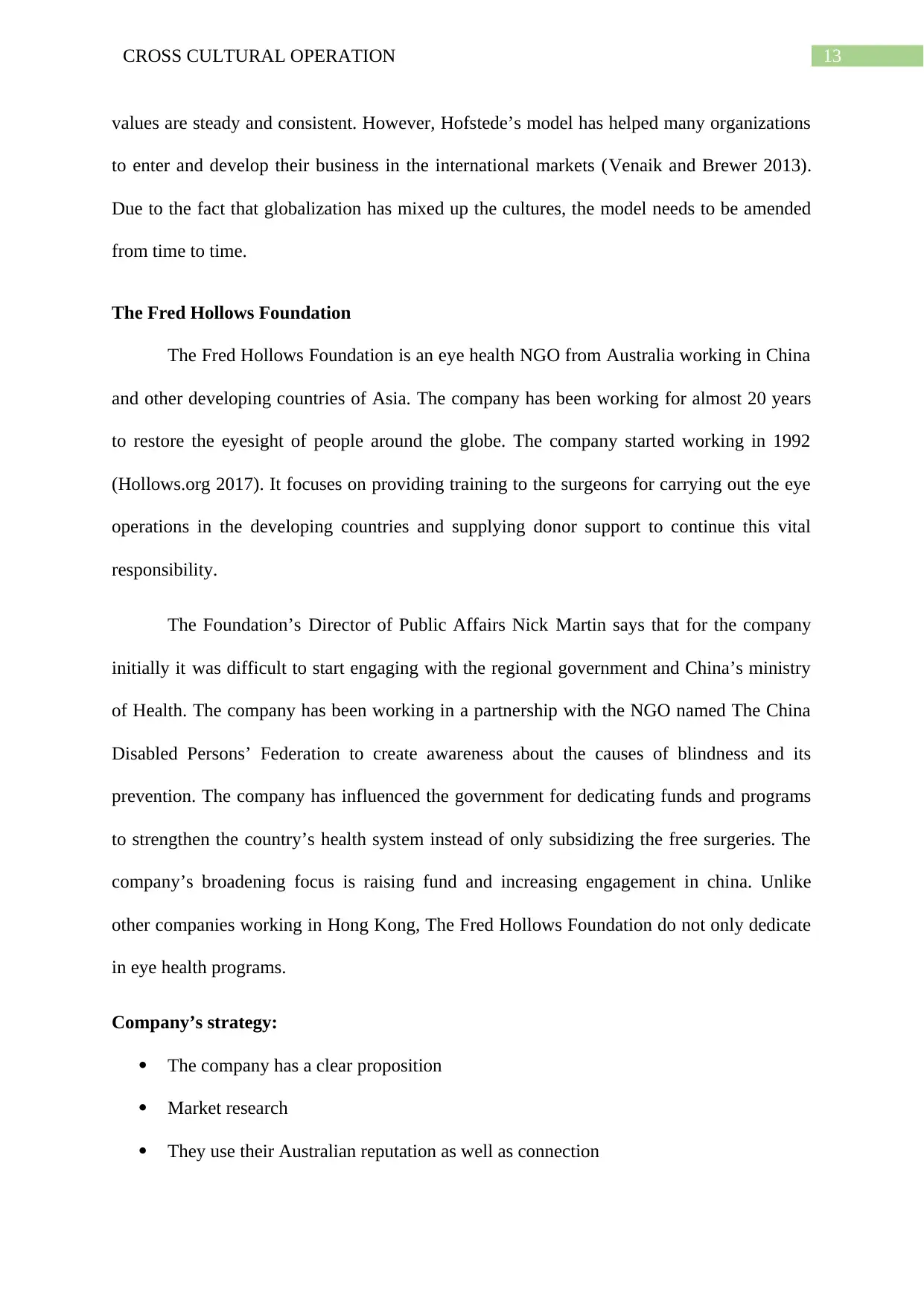
13CROSS CULTURAL OPERATION
values are steady and consistent. However, Hofstede’s model has helped many organizations
to enter and develop their business in the international markets (Venaik and Brewer 2013).
Due to the fact that globalization has mixed up the cultures, the model needs to be amended
from time to time.
The Fred Hollows Foundation
The Fred Hollows Foundation is an eye health NGO from Australia working in China
and other developing countries of Asia. The company has been working for almost 20 years
to restore the eyesight of people around the globe. The company started working in 1992
(Hollows.org 2017). It focuses on providing training to the surgeons for carrying out the eye
operations in the developing countries and supplying donor support to continue this vital
responsibility.
The Foundation’s Director of Public Affairs Nick Martin says that for the company
initially it was difficult to start engaging with the regional government and China’s ministry
of Health. The company has been working in a partnership with the NGO named The China
Disabled Persons’ Federation to create awareness about the causes of blindness and its
prevention. The company has influenced the government for dedicating funds and programs
to strengthen the country’s health system instead of only subsidizing the free surgeries. The
company’s broadening focus is raising fund and increasing engagement in china. Unlike
other companies working in Hong Kong, The Fred Hollows Foundation do not only dedicate
in eye health programs.
Company’s strategy:
The company has a clear proposition
Market research
They use their Australian reputation as well as connection
values are steady and consistent. However, Hofstede’s model has helped many organizations
to enter and develop their business in the international markets (Venaik and Brewer 2013).
Due to the fact that globalization has mixed up the cultures, the model needs to be amended
from time to time.
The Fred Hollows Foundation
The Fred Hollows Foundation is an eye health NGO from Australia working in China
and other developing countries of Asia. The company has been working for almost 20 years
to restore the eyesight of people around the globe. The company started working in 1992
(Hollows.org 2017). It focuses on providing training to the surgeons for carrying out the eye
operations in the developing countries and supplying donor support to continue this vital
responsibility.
The Foundation’s Director of Public Affairs Nick Martin says that for the company
initially it was difficult to start engaging with the regional government and China’s ministry
of Health. The company has been working in a partnership with the NGO named The China
Disabled Persons’ Federation to create awareness about the causes of blindness and its
prevention. The company has influenced the government for dedicating funds and programs
to strengthen the country’s health system instead of only subsidizing the free surgeries. The
company’s broadening focus is raising fund and increasing engagement in china. Unlike
other companies working in Hong Kong, The Fred Hollows Foundation do not only dedicate
in eye health programs.
Company’s strategy:
The company has a clear proposition
Market research
They use their Australian reputation as well as connection
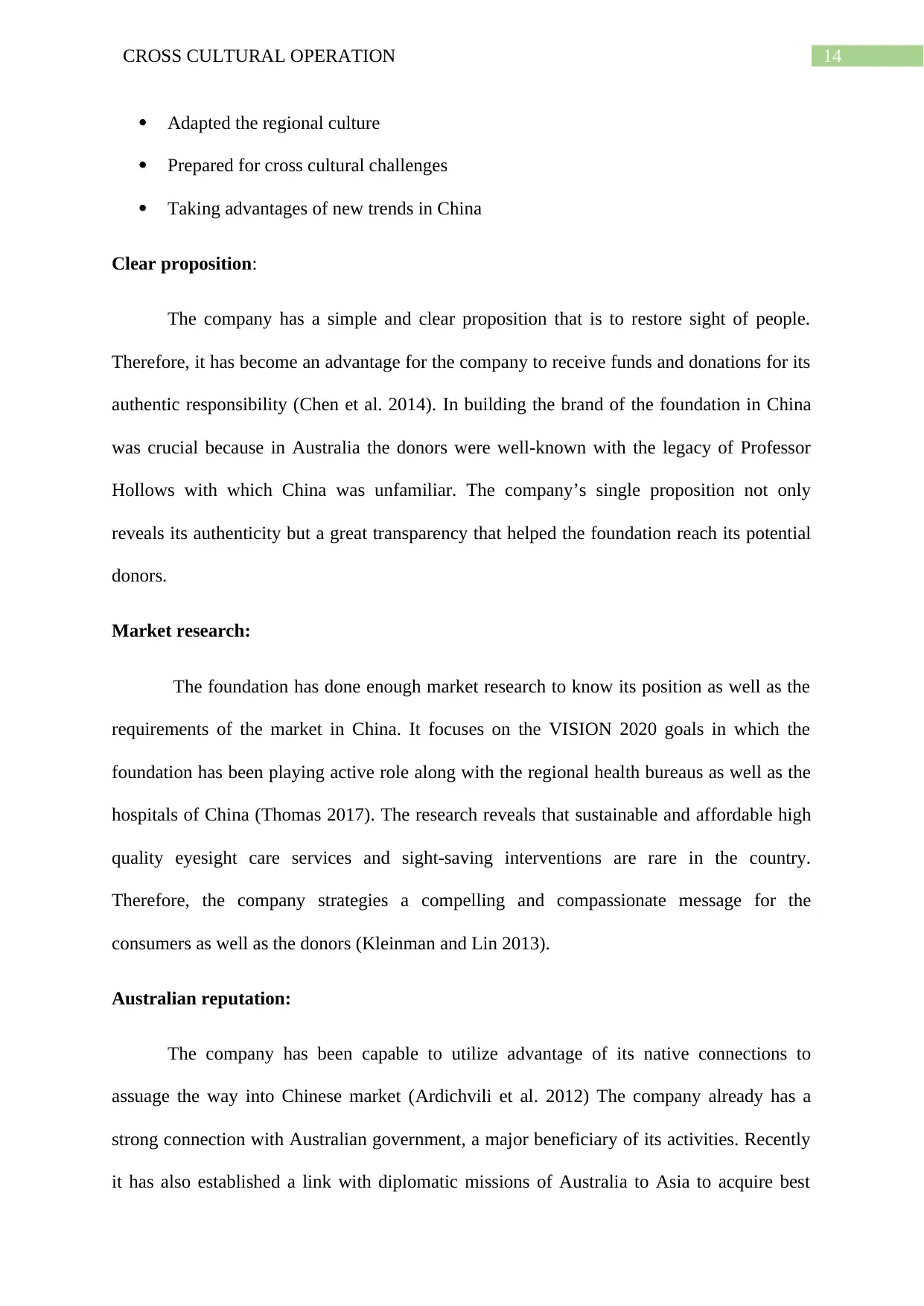
14CROSS CULTURAL OPERATION
Adapted the regional culture
Prepared for cross cultural challenges
Taking advantages of new trends in China
Clear proposition:
The company has a simple and clear proposition that is to restore sight of people.
Therefore, it has become an advantage for the company to receive funds and donations for its
authentic responsibility (Chen et al. 2014). In building the brand of the foundation in China
was crucial because in Australia the donors were well-known with the legacy of Professor
Hollows with which China was unfamiliar. The company’s single proposition not only
reveals its authenticity but a great transparency that helped the foundation reach its potential
donors.
Market research:
The foundation has done enough market research to know its position as well as the
requirements of the market in China. It focuses on the VISION 2020 goals in which the
foundation has been playing active role along with the regional health bureaus as well as the
hospitals of China (Thomas 2017). The research reveals that sustainable and affordable high
quality eyesight care services and sight-saving interventions are rare in the country.
Therefore, the company strategies a compelling and compassionate message for the
consumers as well as the donors (Kleinman and Lin 2013).
Australian reputation:
The company has been capable to utilize advantage of its native connections to
assuage the way into Chinese market (Ardichvili et al. 2012) The company already has a
strong connection with Australian government, a major beneficiary of its activities. Recently
it has also established a link with diplomatic missions of Australia to Asia to acquire best
Adapted the regional culture
Prepared for cross cultural challenges
Taking advantages of new trends in China
Clear proposition:
The company has a simple and clear proposition that is to restore sight of people.
Therefore, it has become an advantage for the company to receive funds and donations for its
authentic responsibility (Chen et al. 2014). In building the brand of the foundation in China
was crucial because in Australia the donors were well-known with the legacy of Professor
Hollows with which China was unfamiliar. The company’s single proposition not only
reveals its authenticity but a great transparency that helped the foundation reach its potential
donors.
Market research:
The foundation has done enough market research to know its position as well as the
requirements of the market in China. It focuses on the VISION 2020 goals in which the
foundation has been playing active role along with the regional health bureaus as well as the
hospitals of China (Thomas 2017). The research reveals that sustainable and affordable high
quality eyesight care services and sight-saving interventions are rare in the country.
Therefore, the company strategies a compelling and compassionate message for the
consumers as well as the donors (Kleinman and Lin 2013).
Australian reputation:
The company has been capable to utilize advantage of its native connections to
assuage the way into Chinese market (Ardichvili et al. 2012) The company already has a
strong connection with Australian government, a major beneficiary of its activities. Recently
it has also established a link with diplomatic missions of Australia to Asia to acquire best
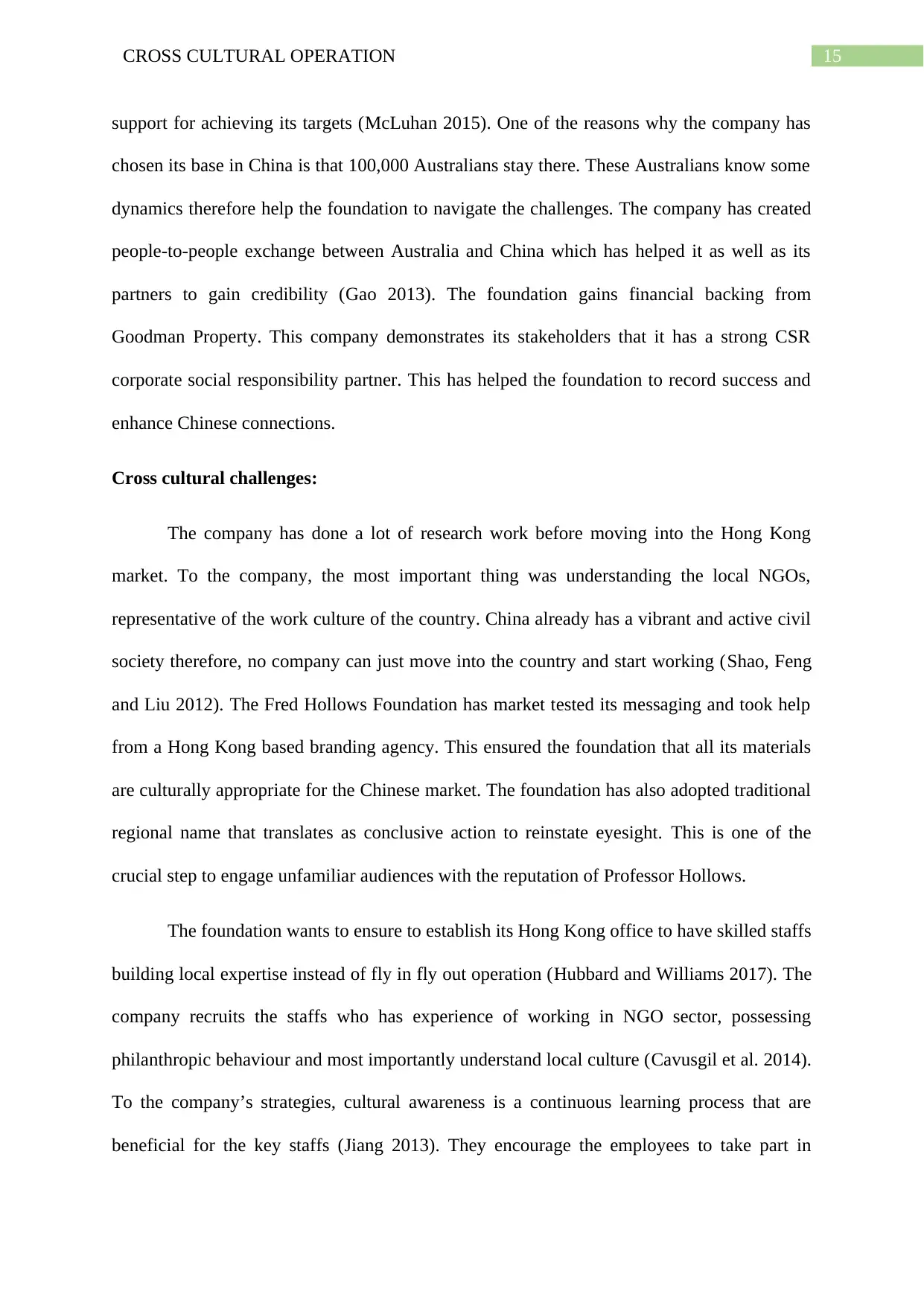
15CROSS CULTURAL OPERATION
support for achieving its targets (McLuhan 2015). One of the reasons why the company has
chosen its base in China is that 100,000 Australians stay there. These Australians know some
dynamics therefore help the foundation to navigate the challenges. The company has created
people-to-people exchange between Australia and China which has helped it as well as its
partners to gain credibility (Gao 2013). The foundation gains financial backing from
Goodman Property. This company demonstrates its stakeholders that it has a strong CSR
corporate social responsibility partner. This has helped the foundation to record success and
enhance Chinese connections.
Cross cultural challenges:
The company has done a lot of research work before moving into the Hong Kong
market. To the company, the most important thing was understanding the local NGOs,
representative of the work culture of the country. China already has a vibrant and active civil
society therefore, no company can just move into the country and start working (Shao, Feng
and Liu 2012). The Fred Hollows Foundation has market tested its messaging and took help
from a Hong Kong based branding agency. This ensured the foundation that all its materials
are culturally appropriate for the Chinese market. The foundation has also adopted traditional
regional name that translates as conclusive action to reinstate eyesight. This is one of the
crucial step to engage unfamiliar audiences with the reputation of Professor Hollows.
The foundation wants to ensure to establish its Hong Kong office to have skilled staffs
building local expertise instead of fly in fly out operation (Hubbard and Williams 2017). The
company recruits the staffs who has experience of working in NGO sector, possessing
philanthropic behaviour and most importantly understand local culture (Cavusgil et al. 2014).
To the company’s strategies, cultural awareness is a continuous learning process that are
beneficial for the key staffs (Jiang 2013). They encourage the employees to take part in
support for achieving its targets (McLuhan 2015). One of the reasons why the company has
chosen its base in China is that 100,000 Australians stay there. These Australians know some
dynamics therefore help the foundation to navigate the challenges. The company has created
people-to-people exchange between Australia and China which has helped it as well as its
partners to gain credibility (Gao 2013). The foundation gains financial backing from
Goodman Property. This company demonstrates its stakeholders that it has a strong CSR
corporate social responsibility partner. This has helped the foundation to record success and
enhance Chinese connections.
Cross cultural challenges:
The company has done a lot of research work before moving into the Hong Kong
market. To the company, the most important thing was understanding the local NGOs,
representative of the work culture of the country. China already has a vibrant and active civil
society therefore, no company can just move into the country and start working (Shao, Feng
and Liu 2012). The Fred Hollows Foundation has market tested its messaging and took help
from a Hong Kong based branding agency. This ensured the foundation that all its materials
are culturally appropriate for the Chinese market. The foundation has also adopted traditional
regional name that translates as conclusive action to reinstate eyesight. This is one of the
crucial step to engage unfamiliar audiences with the reputation of Professor Hollows.
The foundation wants to ensure to establish its Hong Kong office to have skilled staffs
building local expertise instead of fly in fly out operation (Hubbard and Williams 2017). The
company recruits the staffs who has experience of working in NGO sector, possessing
philanthropic behaviour and most importantly understand local culture (Cavusgil et al. 2014).
To the company’s strategies, cultural awareness is a continuous learning process that are
beneficial for the key staffs (Jiang 2013). They encourage the employees to take part in
Secure Best Marks with AI Grader
Need help grading? Try our AI Grader for instant feedback on your assignments.
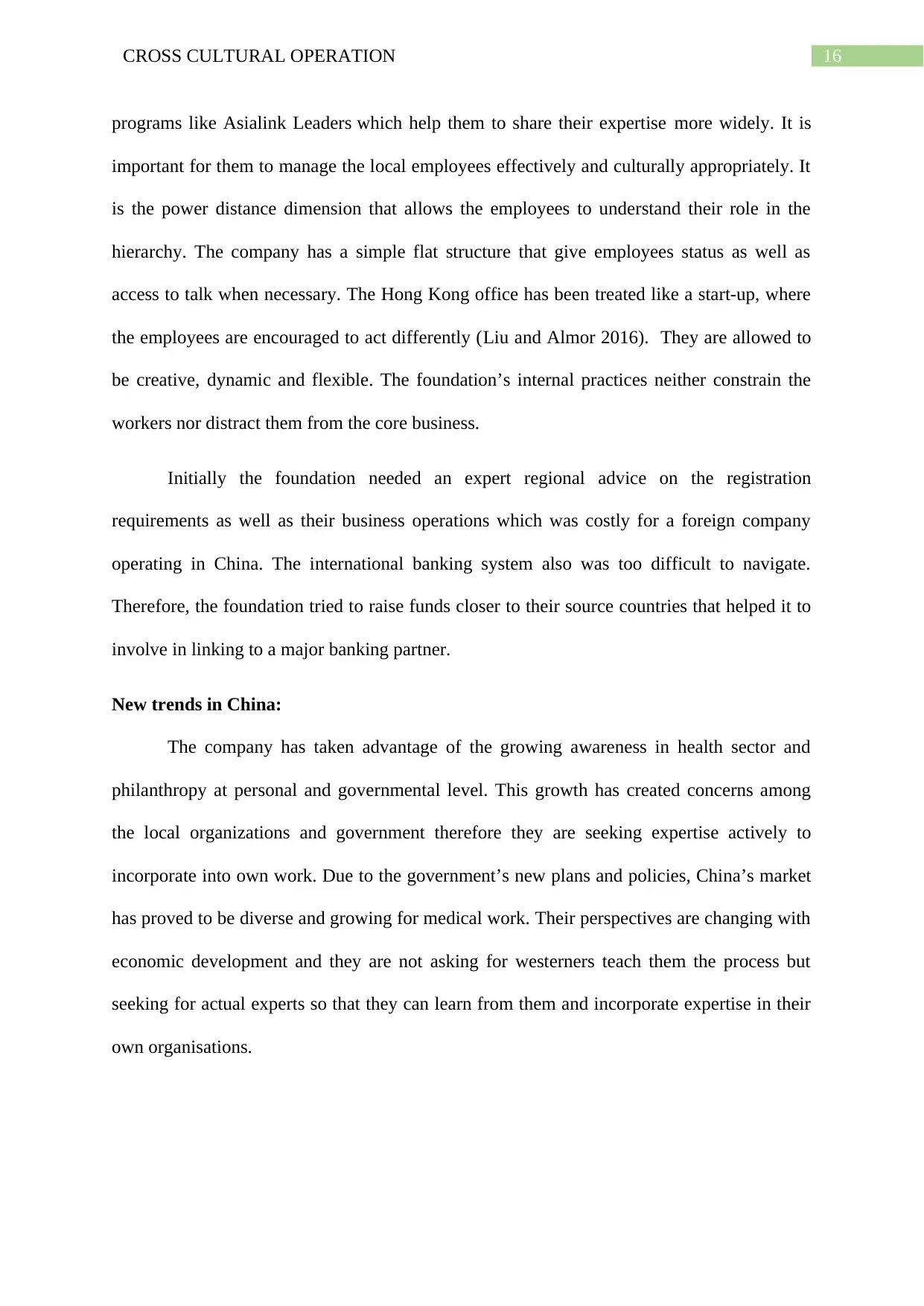
16CROSS CULTURAL OPERATION
programs like Asialink Leaders which help them to share their expertise more widely. It is
important for them to manage the local employees effectively and culturally appropriately. It
is the power distance dimension that allows the employees to understand their role in the
hierarchy. The company has a simple flat structure that give employees status as well as
access to talk when necessary. The Hong Kong office has been treated like a start-up, where
the employees are encouraged to act differently (Liu and Almor 2016). They are allowed to
be creative, dynamic and flexible. The foundation’s internal practices neither constrain the
workers nor distract them from the core business.
Initially the foundation needed an expert regional advice on the registration
requirements as well as their business operations which was costly for a foreign company
operating in China. The international banking system also was too difficult to navigate.
Therefore, the foundation tried to raise funds closer to their source countries that helped it to
involve in linking to a major banking partner.
New trends in China:
The company has taken advantage of the growing awareness in health sector and
philanthropy at personal and governmental level. This growth has created concerns among
the local organizations and government therefore they are seeking expertise actively to
incorporate into own work. Due to the government’s new plans and policies, China’s market
has proved to be diverse and growing for medical work. Their perspectives are changing with
economic development and they are not asking for westerners teach them the process but
seeking for actual experts so that they can learn from them and incorporate expertise in their
own organisations.
programs like Asialink Leaders which help them to share their expertise more widely. It is
important for them to manage the local employees effectively and culturally appropriately. It
is the power distance dimension that allows the employees to understand their role in the
hierarchy. The company has a simple flat structure that give employees status as well as
access to talk when necessary. The Hong Kong office has been treated like a start-up, where
the employees are encouraged to act differently (Liu and Almor 2016). They are allowed to
be creative, dynamic and flexible. The foundation’s internal practices neither constrain the
workers nor distract them from the core business.
Initially the foundation needed an expert regional advice on the registration
requirements as well as their business operations which was costly for a foreign company
operating in China. The international banking system also was too difficult to navigate.
Therefore, the foundation tried to raise funds closer to their source countries that helped it to
involve in linking to a major banking partner.
New trends in China:
The company has taken advantage of the growing awareness in health sector and
philanthropy at personal and governmental level. This growth has created concerns among
the local organizations and government therefore they are seeking expertise actively to
incorporate into own work. Due to the government’s new plans and policies, China’s market
has proved to be diverse and growing for medical work. Their perspectives are changing with
economic development and they are not asking for westerners teach them the process but
seeking for actual experts so that they can learn from them and incorporate expertise in their
own organisations.
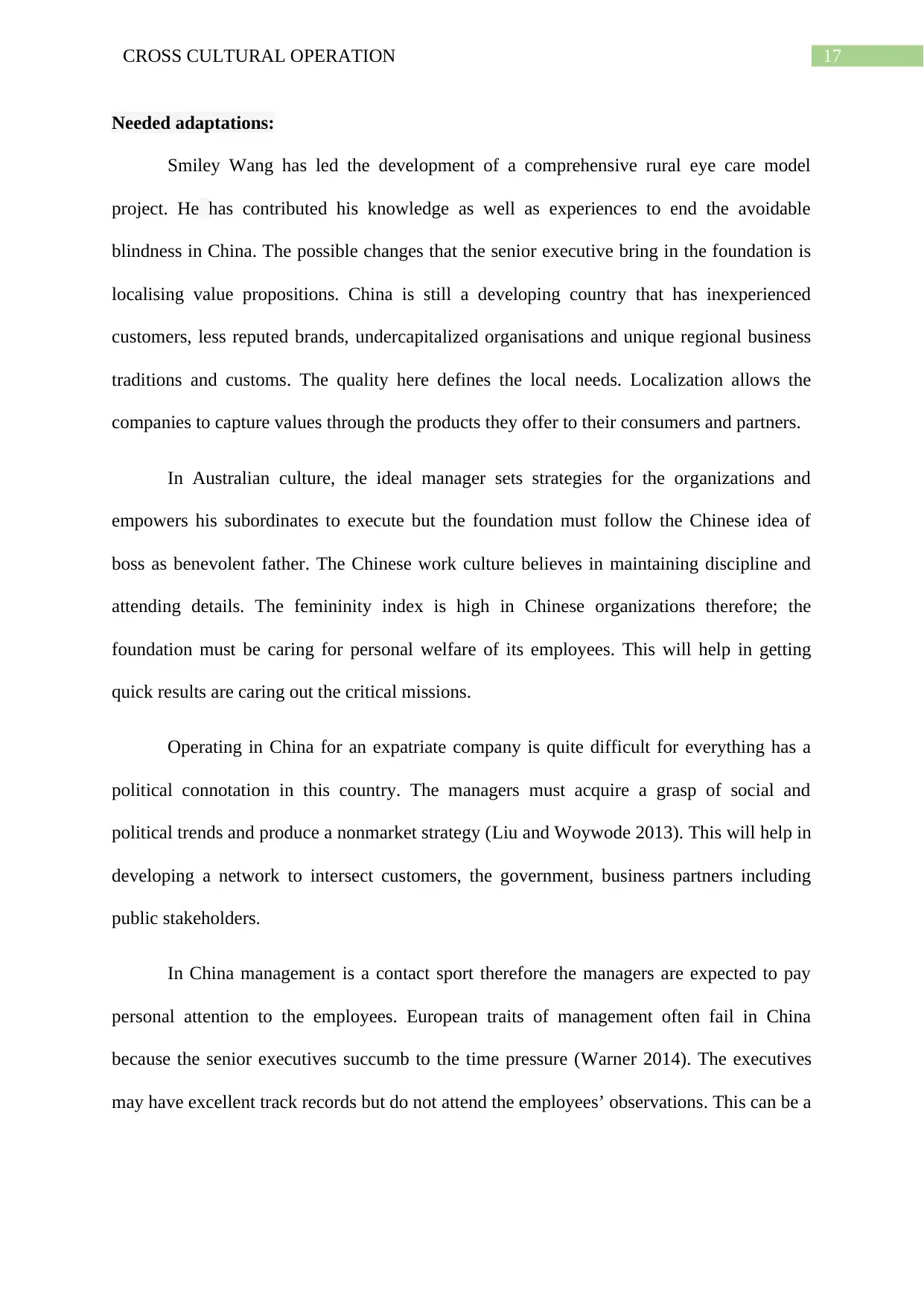
17CROSS CULTURAL OPERATION
Needed adaptations:
Smiley Wang has led the development of a comprehensive rural eye care model
project. He has contributed his knowledge as well as experiences to end the avoidable
blindness in China. The possible changes that the senior executive bring in the foundation is
localising value propositions. China is still a developing country that has inexperienced
customers, less reputed brands, undercapitalized organisations and unique regional business
traditions and customs. The quality here defines the local needs. Localization allows the
companies to capture values through the products they offer to their consumers and partners.
In Australian culture, the ideal manager sets strategies for the organizations and
empowers his subordinates to execute but the foundation must follow the Chinese idea of
boss as benevolent father. The Chinese work culture believes in maintaining discipline and
attending details. The femininity index is high in Chinese organizations therefore; the
foundation must be caring for personal welfare of its employees. This will help in getting
quick results are caring out the critical missions.
Operating in China for an expatriate company is quite difficult for everything has a
political connotation in this country. The managers must acquire a grasp of social and
political trends and produce a nonmarket strategy (Liu and Woywode 2013). This will help in
developing a network to intersect customers, the government, business partners including
public stakeholders.
In China management is a contact sport therefore the managers are expected to pay
personal attention to the employees. European traits of management often fail in China
because the senior executives succumb to the time pressure (Warner 2014). The executives
may have excellent track records but do not attend the employees’ observations. This can be a
Needed adaptations:
Smiley Wang has led the development of a comprehensive rural eye care model
project. He has contributed his knowledge as well as experiences to end the avoidable
blindness in China. The possible changes that the senior executive bring in the foundation is
localising value propositions. China is still a developing country that has inexperienced
customers, less reputed brands, undercapitalized organisations and unique regional business
traditions and customs. The quality here defines the local needs. Localization allows the
companies to capture values through the products they offer to their consumers and partners.
In Australian culture, the ideal manager sets strategies for the organizations and
empowers his subordinates to execute but the foundation must follow the Chinese idea of
boss as benevolent father. The Chinese work culture believes in maintaining discipline and
attending details. The femininity index is high in Chinese organizations therefore; the
foundation must be caring for personal welfare of its employees. This will help in getting
quick results are caring out the critical missions.
Operating in China for an expatriate company is quite difficult for everything has a
political connotation in this country. The managers must acquire a grasp of social and
political trends and produce a nonmarket strategy (Liu and Woywode 2013). This will help in
developing a network to intersect customers, the government, business partners including
public stakeholders.
In China management is a contact sport therefore the managers are expected to pay
personal attention to the employees. European traits of management often fail in China
because the senior executives succumb to the time pressure (Warner 2014). The executives
may have excellent track records but do not attend the employees’ observations. This can be a
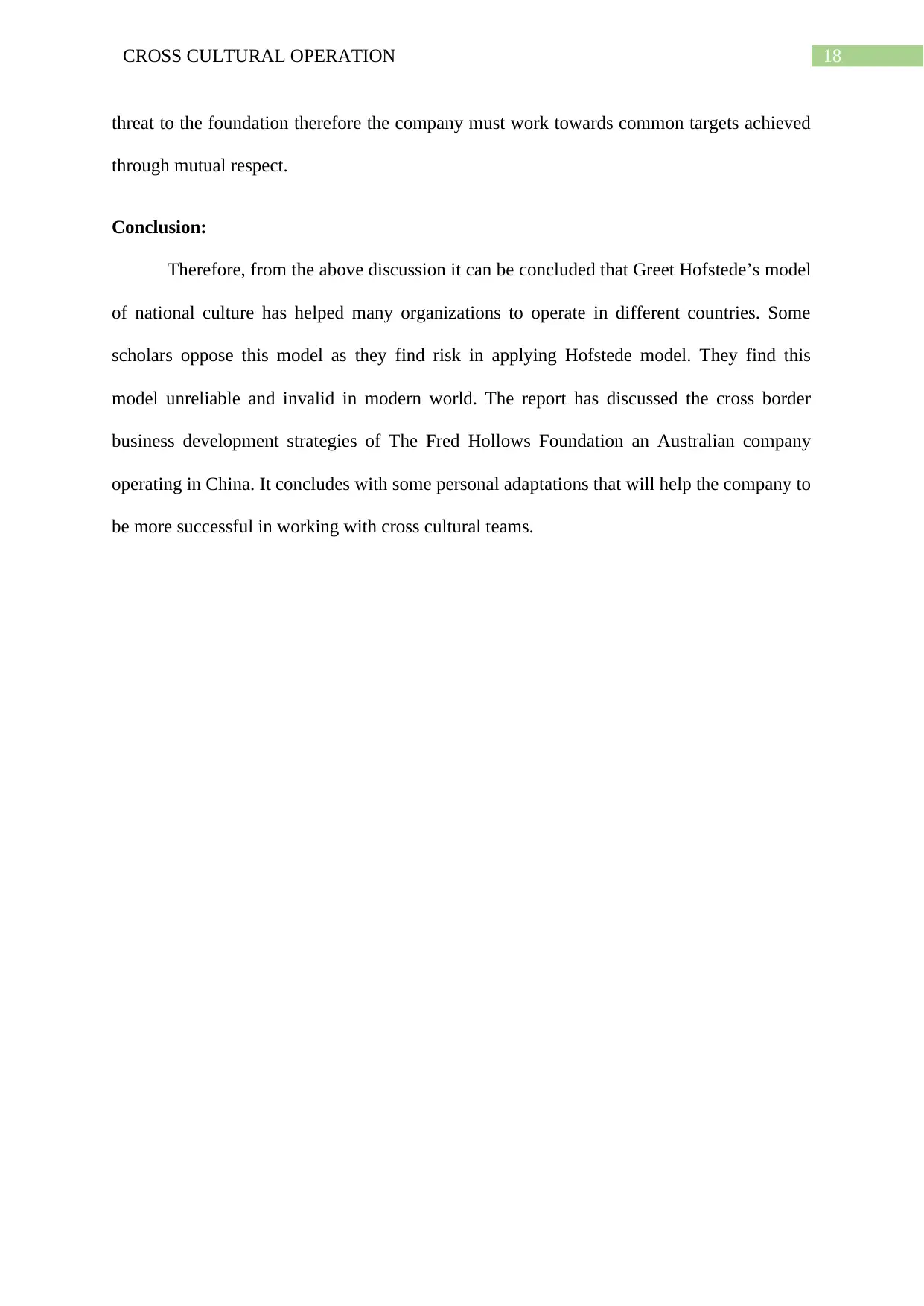
18CROSS CULTURAL OPERATION
threat to the foundation therefore the company must work towards common targets achieved
through mutual respect.
Conclusion:
Therefore, from the above discussion it can be concluded that Greet Hofstede’s model
of national culture has helped many organizations to operate in different countries. Some
scholars oppose this model as they find risk in applying Hofstede model. They find this
model unreliable and invalid in modern world. The report has discussed the cross border
business development strategies of The Fred Hollows Foundation an Australian company
operating in China. It concludes with some personal adaptations that will help the company to
be more successful in working with cross cultural teams.
threat to the foundation therefore the company must work towards common targets achieved
through mutual respect.
Conclusion:
Therefore, from the above discussion it can be concluded that Greet Hofstede’s model
of national culture has helped many organizations to operate in different countries. Some
scholars oppose this model as they find risk in applying Hofstede model. They find this
model unreliable and invalid in modern world. The report has discussed the cross border
business development strategies of The Fred Hollows Foundation an Australian company
operating in China. It concludes with some personal adaptations that will help the company to
be more successful in working with cross cultural teams.
Paraphrase This Document
Need a fresh take? Get an instant paraphrase of this document with our AI Paraphraser
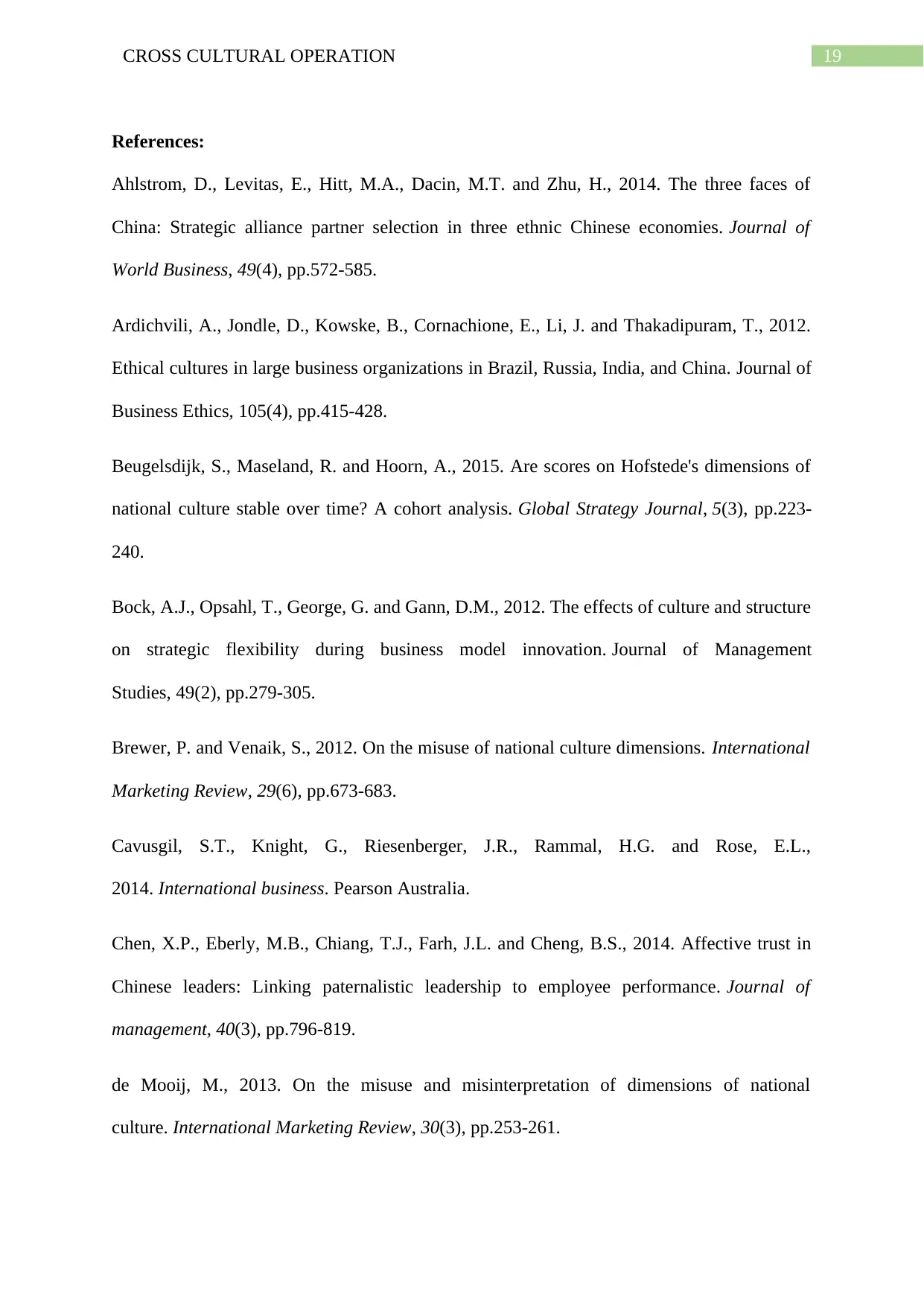
19CROSS CULTURAL OPERATION
References:
Ahlstrom, D., Levitas, E., Hitt, M.A., Dacin, M.T. and Zhu, H., 2014. The three faces of
China: Strategic alliance partner selection in three ethnic Chinese economies. Journal of
World Business, 49(4), pp.572-585.
Ardichvili, A., Jondle, D., Kowske, B., Cornachione, E., Li, J. and Thakadipuram, T., 2012.
Ethical cultures in large business organizations in Brazil, Russia, India, and China. Journal of
Business Ethics, 105(4), pp.415-428.
Beugelsdijk, S., Maseland, R. and Hoorn, A., 2015. Are scores on Hofstede's dimensions of
national culture stable over time? A cohort analysis. Global Strategy Journal, 5(3), pp.223-
240.
Bock, A.J., Opsahl, T., George, G. and Gann, D.M., 2012. The effects of culture and structure
on strategic flexibility during business model innovation. Journal of Management
Studies, 49(2), pp.279-305.
Brewer, P. and Venaik, S., 2012. On the misuse of national culture dimensions. International
Marketing Review, 29(6), pp.673-683.
Cavusgil, S.T., Knight, G., Riesenberger, J.R., Rammal, H.G. and Rose, E.L.,
2014. International business. Pearson Australia.
Chen, X.P., Eberly, M.B., Chiang, T.J., Farh, J.L. and Cheng, B.S., 2014. Affective trust in
Chinese leaders: Linking paternalistic leadership to employee performance. Journal of
management, 40(3), pp.796-819.
de Mooij, M., 2013. On the misuse and misinterpretation of dimensions of national
culture. International Marketing Review, 30(3), pp.253-261.
References:
Ahlstrom, D., Levitas, E., Hitt, M.A., Dacin, M.T. and Zhu, H., 2014. The three faces of
China: Strategic alliance partner selection in three ethnic Chinese economies. Journal of
World Business, 49(4), pp.572-585.
Ardichvili, A., Jondle, D., Kowske, B., Cornachione, E., Li, J. and Thakadipuram, T., 2012.
Ethical cultures in large business organizations in Brazil, Russia, India, and China. Journal of
Business Ethics, 105(4), pp.415-428.
Beugelsdijk, S., Maseland, R. and Hoorn, A., 2015. Are scores on Hofstede's dimensions of
national culture stable over time? A cohort analysis. Global Strategy Journal, 5(3), pp.223-
240.
Bock, A.J., Opsahl, T., George, G. and Gann, D.M., 2012. The effects of culture and structure
on strategic flexibility during business model innovation. Journal of Management
Studies, 49(2), pp.279-305.
Brewer, P. and Venaik, S., 2012. On the misuse of national culture dimensions. International
Marketing Review, 29(6), pp.673-683.
Cavusgil, S.T., Knight, G., Riesenberger, J.R., Rammal, H.G. and Rose, E.L.,
2014. International business. Pearson Australia.
Chen, X.P., Eberly, M.B., Chiang, T.J., Farh, J.L. and Cheng, B.S., 2014. Affective trust in
Chinese leaders: Linking paternalistic leadership to employee performance. Journal of
management, 40(3), pp.796-819.
de Mooij, M., 2013. On the misuse and misinterpretation of dimensions of national
culture. International Marketing Review, 30(3), pp.253-261.
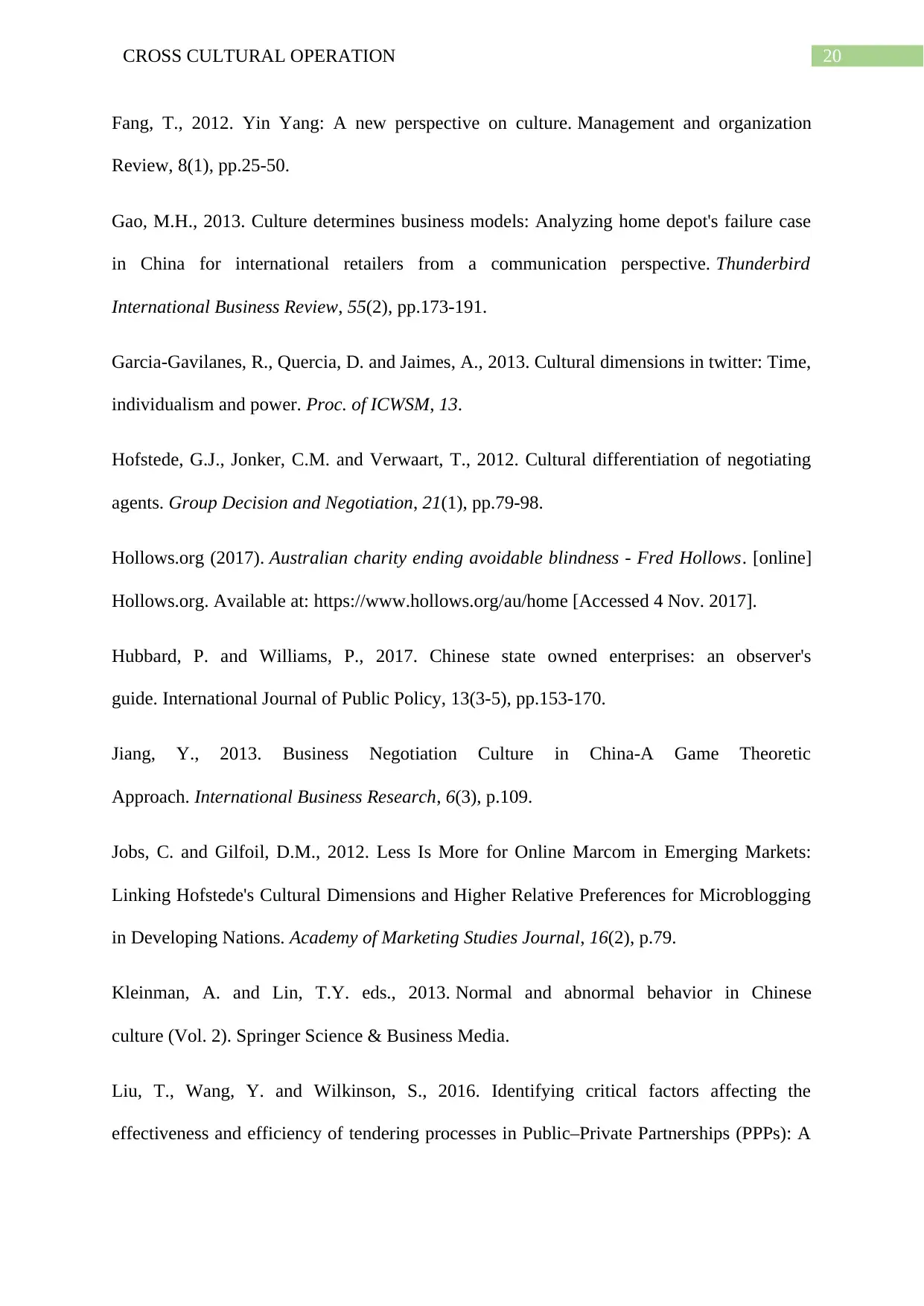
20CROSS CULTURAL OPERATION
Fang, T., 2012. Yin Yang: A new perspective on culture. Management and organization
Review, 8(1), pp.25-50.
Gao, M.H., 2013. Culture determines business models: Analyzing home depot's failure case
in China for international retailers from a communication perspective. Thunderbird
International Business Review, 55(2), pp.173-191.
Garcia-Gavilanes, R., Quercia, D. and Jaimes, A., 2013. Cultural dimensions in twitter: Time,
individualism and power. Proc. of ICWSM, 13.
Hofstede, G.J., Jonker, C.M. and Verwaart, T., 2012. Cultural differentiation of negotiating
agents. Group Decision and Negotiation, 21(1), pp.79-98.
Hollows.org (2017). Australian charity ending avoidable blindness - Fred Hollows. [online]
Hollows.org. Available at: https://www.hollows.org/au/home [Accessed 4 Nov. 2017].
Hubbard, P. and Williams, P., 2017. Chinese state owned enterprises: an observer's
guide. International Journal of Public Policy, 13(3-5), pp.153-170.
Jiang, Y., 2013. Business Negotiation Culture in China-A Game Theoretic
Approach. International Business Research, 6(3), p.109.
Jobs, C. and Gilfoil, D.M., 2012. Less Is More for Online Marcom in Emerging Markets:
Linking Hofstede's Cultural Dimensions and Higher Relative Preferences for Microblogging
in Developing Nations. Academy of Marketing Studies Journal, 16(2), p.79.
Kleinman, A. and Lin, T.Y. eds., 2013. Normal and abnormal behavior in Chinese
culture (Vol. 2). Springer Science & Business Media.
Liu, T., Wang, Y. and Wilkinson, S., 2016. Identifying critical factors affecting the
effectiveness and efficiency of tendering processes in Public–Private Partnerships (PPPs): A
Fang, T., 2012. Yin Yang: A new perspective on culture. Management and organization
Review, 8(1), pp.25-50.
Gao, M.H., 2013. Culture determines business models: Analyzing home depot's failure case
in China for international retailers from a communication perspective. Thunderbird
International Business Review, 55(2), pp.173-191.
Garcia-Gavilanes, R., Quercia, D. and Jaimes, A., 2013. Cultural dimensions in twitter: Time,
individualism and power. Proc. of ICWSM, 13.
Hofstede, G.J., Jonker, C.M. and Verwaart, T., 2012. Cultural differentiation of negotiating
agents. Group Decision and Negotiation, 21(1), pp.79-98.
Hollows.org (2017). Australian charity ending avoidable blindness - Fred Hollows. [online]
Hollows.org. Available at: https://www.hollows.org/au/home [Accessed 4 Nov. 2017].
Hubbard, P. and Williams, P., 2017. Chinese state owned enterprises: an observer's
guide. International Journal of Public Policy, 13(3-5), pp.153-170.
Jiang, Y., 2013. Business Negotiation Culture in China-A Game Theoretic
Approach. International Business Research, 6(3), p.109.
Jobs, C. and Gilfoil, D.M., 2012. Less Is More for Online Marcom in Emerging Markets:
Linking Hofstede's Cultural Dimensions and Higher Relative Preferences for Microblogging
in Developing Nations. Academy of Marketing Studies Journal, 16(2), p.79.
Kleinman, A. and Lin, T.Y. eds., 2013. Normal and abnormal behavior in Chinese
culture (Vol. 2). Springer Science & Business Media.
Liu, T., Wang, Y. and Wilkinson, S., 2016. Identifying critical factors affecting the
effectiveness and efficiency of tendering processes in Public–Private Partnerships (PPPs): A
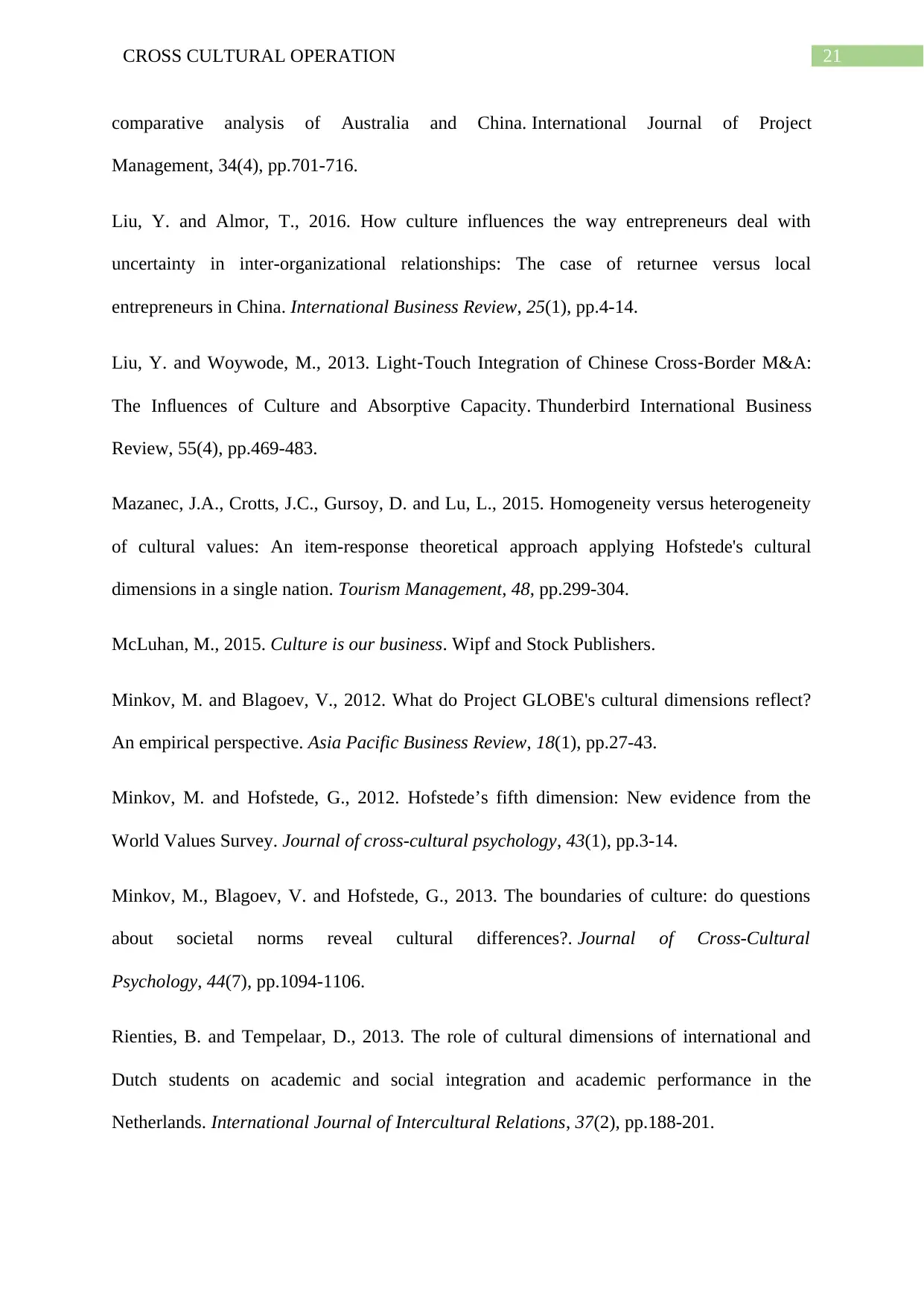
21CROSS CULTURAL OPERATION
comparative analysis of Australia and China. International Journal of Project
Management, 34(4), pp.701-716.
Liu, Y. and Almor, T., 2016. How culture influences the way entrepreneurs deal with
uncertainty in inter-organizational relationships: The case of returnee versus local
entrepreneurs in China. International Business Review, 25(1), pp.4-14.
Liu, Y. and Woywode, M., 2013. Light‐Touch Integration of Chinese Cross‐Border M&A:
The Influences of Culture and Absorptive Capacity. Thunderbird International Business
Review, 55(4), pp.469-483.
Mazanec, J.A., Crotts, J.C., Gursoy, D. and Lu, L., 2015. Homogeneity versus heterogeneity
of cultural values: An item-response theoretical approach applying Hofstede's cultural
dimensions in a single nation. Tourism Management, 48, pp.299-304.
McLuhan, M., 2015. Culture is our business. Wipf and Stock Publishers.
Minkov, M. and Blagoev, V., 2012. What do Project GLOBE's cultural dimensions reflect?
An empirical perspective. Asia Pacific Business Review, 18(1), pp.27-43.
Minkov, M. and Hofstede, G., 2012. Hofstede’s fifth dimension: New evidence from the
World Values Survey. Journal of cross-cultural psychology, 43(1), pp.3-14.
Minkov, M., Blagoev, V. and Hofstede, G., 2013. The boundaries of culture: do questions
about societal norms reveal cultural differences?. Journal of Cross-Cultural
Psychology, 44(7), pp.1094-1106.
Rienties, B. and Tempelaar, D., 2013. The role of cultural dimensions of international and
Dutch students on academic and social integration and academic performance in the
Netherlands. International Journal of Intercultural Relations, 37(2), pp.188-201.
comparative analysis of Australia and China. International Journal of Project
Management, 34(4), pp.701-716.
Liu, Y. and Almor, T., 2016. How culture influences the way entrepreneurs deal with
uncertainty in inter-organizational relationships: The case of returnee versus local
entrepreneurs in China. International Business Review, 25(1), pp.4-14.
Liu, Y. and Woywode, M., 2013. Light‐Touch Integration of Chinese Cross‐Border M&A:
The Influences of Culture and Absorptive Capacity. Thunderbird International Business
Review, 55(4), pp.469-483.
Mazanec, J.A., Crotts, J.C., Gursoy, D. and Lu, L., 2015. Homogeneity versus heterogeneity
of cultural values: An item-response theoretical approach applying Hofstede's cultural
dimensions in a single nation. Tourism Management, 48, pp.299-304.
McLuhan, M., 2015. Culture is our business. Wipf and Stock Publishers.
Minkov, M. and Blagoev, V., 2012. What do Project GLOBE's cultural dimensions reflect?
An empirical perspective. Asia Pacific Business Review, 18(1), pp.27-43.
Minkov, M. and Hofstede, G., 2012. Hofstede’s fifth dimension: New evidence from the
World Values Survey. Journal of cross-cultural psychology, 43(1), pp.3-14.
Minkov, M., Blagoev, V. and Hofstede, G., 2013. The boundaries of culture: do questions
about societal norms reveal cultural differences?. Journal of Cross-Cultural
Psychology, 44(7), pp.1094-1106.
Rienties, B. and Tempelaar, D., 2013. The role of cultural dimensions of international and
Dutch students on academic and social integration and academic performance in the
Netherlands. International Journal of Intercultural Relations, 37(2), pp.188-201.
Secure Best Marks with AI Grader
Need help grading? Try our AI Grader for instant feedback on your assignments.
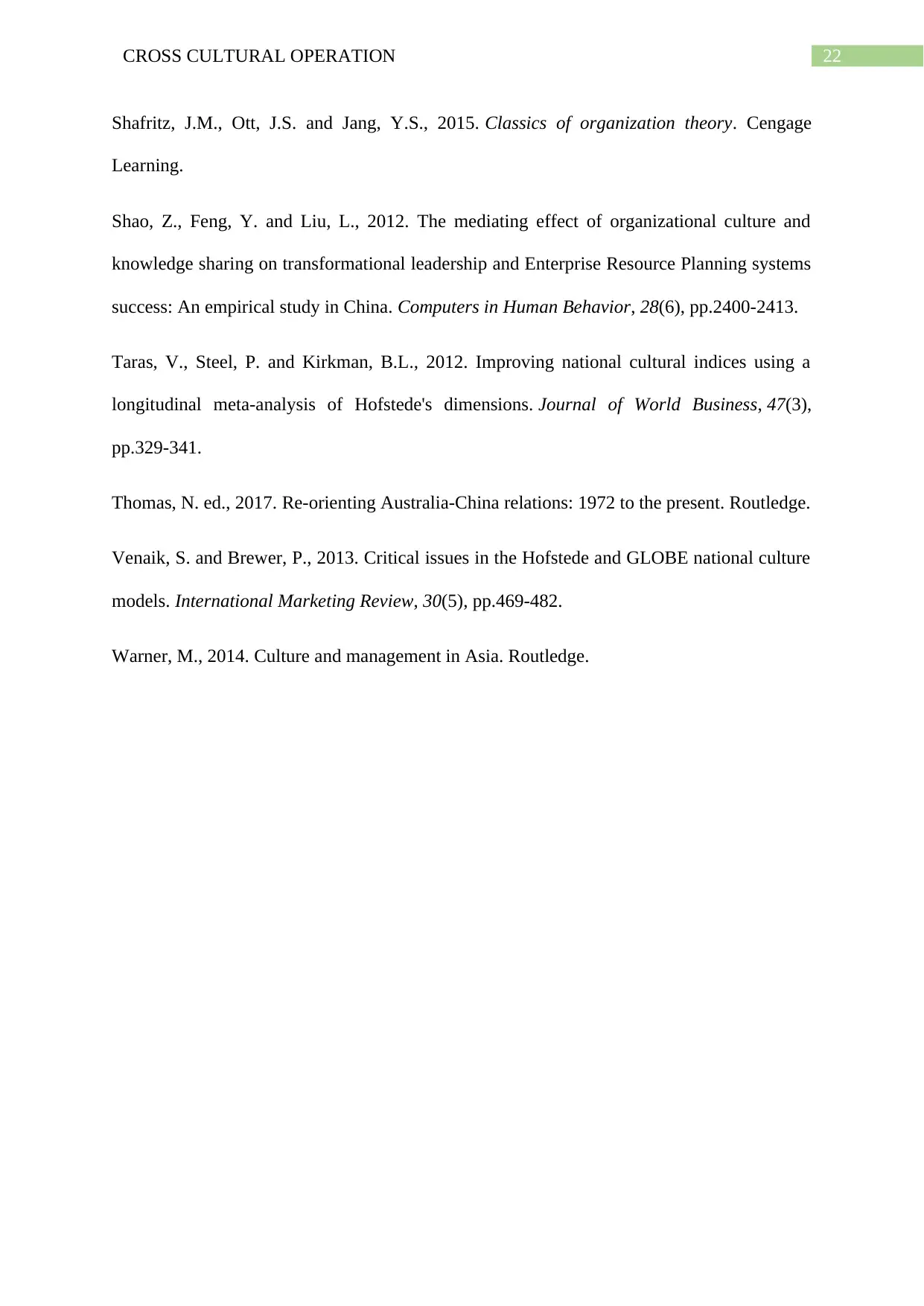
22CROSS CULTURAL OPERATION
Shafritz, J.M., Ott, J.S. and Jang, Y.S., 2015. Classics of organization theory. Cengage
Learning.
Shao, Z., Feng, Y. and Liu, L., 2012. The mediating effect of organizational culture and
knowledge sharing on transformational leadership and Enterprise Resource Planning systems
success: An empirical study in China. Computers in Human Behavior, 28(6), pp.2400-2413.
Taras, V., Steel, P. and Kirkman, B.L., 2012. Improving national cultural indices using a
longitudinal meta-analysis of Hofstede's dimensions. Journal of World Business, 47(3),
pp.329-341.
Thomas, N. ed., 2017. Re-orienting Australia-China relations: 1972 to the present. Routledge.
Venaik, S. and Brewer, P., 2013. Critical issues in the Hofstede and GLOBE national culture
models. International Marketing Review, 30(5), pp.469-482.
Warner, M., 2014. Culture and management in Asia. Routledge.
Shafritz, J.M., Ott, J.S. and Jang, Y.S., 2015. Classics of organization theory. Cengage
Learning.
Shao, Z., Feng, Y. and Liu, L., 2012. The mediating effect of organizational culture and
knowledge sharing on transformational leadership and Enterprise Resource Planning systems
success: An empirical study in China. Computers in Human Behavior, 28(6), pp.2400-2413.
Taras, V., Steel, P. and Kirkman, B.L., 2012. Improving national cultural indices using a
longitudinal meta-analysis of Hofstede's dimensions. Journal of World Business, 47(3),
pp.329-341.
Thomas, N. ed., 2017. Re-orienting Australia-China relations: 1972 to the present. Routledge.
Venaik, S. and Brewer, P., 2013. Critical issues in the Hofstede and GLOBE national culture
models. International Marketing Review, 30(5), pp.469-482.
Warner, M., 2014. Culture and management in Asia. Routledge.

23CROSS CULTURAL OPERATION
1 out of 24
Your All-in-One AI-Powered Toolkit for Academic Success.
+13062052269
info@desklib.com
Available 24*7 on WhatsApp / Email
![[object Object]](/_next/static/media/star-bottom.7253800d.svg)
Unlock your academic potential
© 2024 | Zucol Services PVT LTD | All rights reserved.



